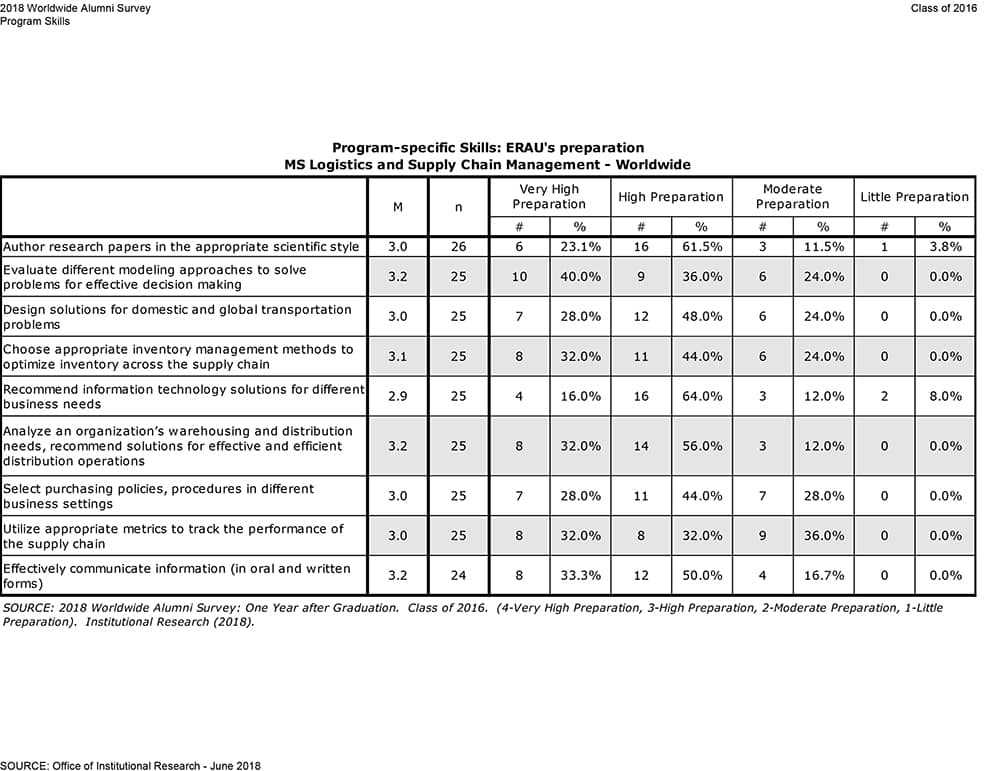Worldwide Undergraduate Degrees
Program Mission Statement
The mission of the Associate of Science in Engineering Fundamentals degree program is to provide a broad and cost-effective access to an Embry-Riddle Aeronautical University education in engineering. Covered topics include, but are not limited to, mathematics, physics, programming, and fundamental engineering concepts. The educational focus aligns mostly with the first two years of typical mechanical, robotics, or aerospace engineering programs. Finally, the goal is for students to continue with a Bachelor of Science in Engineering, possibly at one of Embry-Riddle's residential campuses, other academic institutions, or pursue related professional certifications.
Program Outcomes
| Practice a Profession |
| Within a few years after graduation, students will practice a profession, where fundamental engineering skills, professional certifications, or employment in STEM related fields are sought, or ... |
| Further Education |
| ... will have successfully pursued an undergraduate engineering or professional degree in a technical, business, law, or medical field. |
| Team, Ethics, Lifelong Learning |
| Within a few years after graduation, students will continue to be involved in lifelong learning processes and practice their profession ethically while demonstrating excellent teamwork and communication skills. |
| Math, Science |
| Graduates have an ability to apply knowledge of mathematics, sciences, and other related disciplines. |
| Experiment, Data |
| Graduates have an ability to conduct experiments, as well as to analyze and interpret data |
| Applied Science, Engineering, Professional Practice |
| Graduates have an ability to identify, formulate, and solve applied science problems. They also have an ability to use the techniques, skills, and modern applied science tools necessary for professional practice. |
| Teams, Communication |
| Graduates have an ability to function on teams and communicate effectively. |
| Ethics, Lifelong Learning, Contemporary Issues |
| Graduates have an understanding of professional and ethical responsibility, a recognition of the need for and an ability to engage in life-long learning, and a knowledge of contemporary issues. |
Enrollment & Degrees Conferred
|
|
Full Time or Part Time* |
Enrollment |
Degrees Conferred** |
|
Fall 2017 |
FT |
0 |
0 |
|
|
PT |
314 |
|
|
Fall 2016 |
FT |
0 |
0 |
|
|
PT |
160 |
|
|
Fall 2015 |
FT |
0 |
0 |
|
|
PT |
21 |
|
|
Fall 2014 |
FT |
0 |
0 |
|
|
PT |
0 |
|
|
Fall 2013 |
FT |
0 |
0 |
|
|
PT |
0 |
|
|
*FT (Full-time) = 30 or more hours attempted in one year. ** Degrees Conferred data are Academic Year totals (for example, Fall 2015 is July 1, 2014 through June 30, 2015) |
|||
AABInternational
|
EMBRY-RIDDLE AERONAUTICAL UNIVERSITY- WORLDWIDE |
|
| B.S. in Aeronautics | |
| December 1, 2023 | STUDENT ACHIEVEMENT DATA |
*Excerpt from AABI Criteria Manual:
Criterion 2.2.4 (2-year programs), Criterion 3.2.4 (4-year programs) or Criterion 4.2.4 (graduate programs) Public Information.
Each AABI-accredited aviation program must provide reliable information to the public on student success in the program, at least annually. The following Student Achievement Data must appear in easily accessible locations including public program websites:
- The Program Educational Goals of each accredited program, as publicly published, and how these Program Educational Goals are assessed by the program.
- Student retention and graduation rates, including the number of degrees produced each year, the percentage of students enrolled one year after starting the program, and the percentage of bachelor’s students graduating within six years.
- The employment rate and types of employment (aviation, aviation-related or other positions) of full-time graduates within one year of graduation.
- Other student achievement data, as determined by the program.
Objectives of Accredited Program
Mission Statement
The purpose of the Aeronautics degree is to serve as an interdisciplinary educational aviation oriented experience. The degree incorporates rigorous academic study tailored to meet individualized educational needs. The philosophy of the Aeronautics degree is that ethical and responsible behavior, within a culture of safety and professionalism, is imperative for the success of its graduates. This degree is designed to facilitate learning for students pursuing an aviation related career. This degree acknowledges a student’s valuable, acquired experience through the award of advanced standing credit based upon prior learning.
BSA Program Goals
- serving the student body, the department and college, and external constituencies in support of the university’s overall mission
- utilizing top quality faculty and instructional staff to educate students
- developing skills in mathematics, physics, communications and aeronautics
- affording interdisciplinary educational opportunities
- affording the opportunity for acquiring various FAA certifications
- employing advanced laboratories, equipment and other facilities
- collaborating with industry leaders and aviation experts worldwide
BSA Program Objectives
- Preparing students for productive careers
- Preparing students for leadership roles in service around the world
- Maintaining a technologically enriched environment
- Emphasizing learning through collaboration and teamwork
- Demonstrating concern for ethical and responsible behavior
- Cultivating analytical abilities
- Cultivating management abilities
- Developing the professional skills needed for participation in a global community
- Facilitating the highest standards of academic achievement
- Facilitating knowledge discovery
- Providing an interpersonal environment that supports the unique needs of each individual
BSA Program Outcomes
- Critical Thinking- The student will show evidence of knowledge at a synthesis level to define and solve problems within professional and personal environments.
- Quantitative Reasoning- The student will show evidence of the use of digitally-enabled technology and analysis techniques to interpret data for the purpose of drawing valid conclusions and solving associated problems.
- Information Literacy-The student will show evidence of meaningful research, including gathering information from primary and secondary sources and incorporating and documenting source material in their writing.
- Communication- The student will show evidence of communicating concepts in written, digital and oral forms to present technical and non-technical information.
- Scientific Literacy-The student will show evidence of analyzing scientific evidence as it relates to the physical world and its interrelationship with human values and interests.
- Cultural Literacy-The student will show evidence of the analysis of historical events, cultural artifacts, and philosophical concepts.
- Life Long Personal Growth-The student will show evidence of the skills needed to enrich the quality of life through activities which enhance and promote lifetime learning.
- Aviation/Aerospace/Aeronautical Science-The student will show evidence of advanced concepts of aviation, aerospace, and aeronautics to solve problems commonly found in their respective industries.
- Aviation Legislation and Law-The student will show evidence of the basic concepts in national and international legislation and law as they pertain to the aviation, aerospace, and aeronautics industries.
- Aviation Safety-The student will show evidence of basic concepts in aviation safety as they pertain to the aviation, aerospace, and aeronautics industry.
- Aviation Management and Operations-The student will show evidence of sound, ethical, management principles within standard aviation, aerospace, and aeronautics operations.
AABI Student Learning Outcomes – General
Aviation programs MUST demonstrate that graduates are able to:
- apply mathematics, science, and applied sciences to aviation-related disciplines;
- analyze and interpret data;
- work effectively on multi-disciplinary and diverse teams;
- make professional and ethical decisions;
- communicate effectively, using both written and oral communication skills;
- engage in and recognize the need for life-long learning;
- assess contemporary issues;
- use the techniques, skills, and modern technology necessary for professional practice;
- assess the national and international aviation environment;
- apply pertinent knowledge in identifying and solving problems;
- apply knowledge of business sustainability to aviation issues.
AABI Student Learning Outcomes - Aviation Core
Aviation programs MUST demonstrate that their graduates are able to:
- Describe the professional attributes, requirements or certifications, and planning applicable to aviation careers.
- Describe the principles of aircraft design, performance and operating characteristics; and the regulations related to the maintenance of aircraft and associated systems.
- Evaluate aviation safety and the impact of human factors on safety.
- Discuss the impact on aviation operations of international aviation law, including applicable International Civil Aviation Organization (ICAO) or other international standards and practices; and applicable national aviation law, regulations and labor issues.
- Explain the integration of airports, airspace, and air traffic control in managing the National Airspace System.
- Discuss the impact of meteorology and environmental issues on aviation operations.
Program Assessment Measures Employed
Direct Assessment Measures
- Student work in select course activities (exams, quizzes, homework sets, presentations, essays)
- Student work in capstone courses
- Rubric-scored portfolio assessment
- External assessments (such as FAA exams, ETS Major Field Test, Peregrine Academic Services Exam)
Indirect Assessment Measures
- End of course evaluations
- Graduating student surveys
- Alumni surveys
- Employer surveys
Graduation Rates
Highest Credential Earned Within Six Years of Entry
| Worldwide Campus: B.S. in Aeronautics | |||||
| Entry Year (July-June) | 2012-13 | 2013-24 | 2014-15 | 2015-16 | 2016-17 |
| Initial Headcount # | 2096 | 1685 | 1694 | 1687 | 1725 |
| Highest Earned = Certificate | 0.2% | 0.4% | 0.2% | 0.3% | 0.1% |
| Highest Earned = Associate | 3.5% | 3.6% | 3.8% | 4.3% | 3.4% |
| Highest Earned = Bachelor | 27.9% | 29.3% | 32.3% | 29.0% | 31.8% |
| Source: Institutional Research. New first-time and transfer students, based on program at time of entry. Students are counted once according to their highest credential earned. | |||||
Rates and Types of Employment of Graduates
Employment Rates
| Alumni Placement Rates, One Year After Graduation | |||||
| Worldwide Campus: B.S. in Aeronautics | |||||
| Graduation Year | 2017 | 2018 | 2019 | 2020-21 | 2021-22 |
| # of Respondents | 322 | 265 | 346 | 224 | 275 |
| Effective Placement Rate | 93.8% | 92.1% | 91.0% | 96.0% | 94.5% |
| Employment Rate | 89.9% | 90.2% | 87.0% | 90.6% | 90.5% |
| Continuing Education Rate | 4.0% | 1.9% | 4.0% | 5.4% | 4.0% |
| Source: Institutional Research. Based on responses to the Alumni Survey. These figures exclude respondents who were not seeking employment. | |||||
Types of Employment for Graduates
- Accident Investigation/Prevention
- Aircraft Crew Member
- Aircraft Manufacturing
- Airport Management
- Air Traffic Control
- Air Transportation Specialist
- Aviation Maintenance
- Aviation Safety
- Avionics and Electronics
- Consulting
- Education/Instruction/Training
- Ground Support
- Management
- Marketing
- Operations
- Pilot
- Sales
- Technical Writing
Current Position Information
| Job Title | # of Alumni |
| Pilot | 23 |
| First Officer | 15 |
| Production Superintendent | 6 |
| Captain | 5 |
| Systems Engineer | 5 |
| Air Traffic Controller | 4 |
| Aircraft Mechanic | 4 |
| Director Of Maintenance | 4 |
| Flight Instructor | 4 |
| Instructor Pilot | 4 |
| Program Manager | 4 |
| Project Manager | 4 |
| Quality Engineer | 4 |
| Avionics Technician | 3 |
| Certified Flight Instructor | 3 |
| Flight Engineer | 3 |
| Helicopter Pilot | 3 |
| Manufacturing Engineer | 3 |
| Remotely Piloted Aircraft Pilot | 3 |
| Senior Enlisted Leader | 3 |
| Source: Institutional Research. Based on responses to the Alumni Survey. | |
Bachelor of Science in Aviation Business Administration
Metric 1 - Peregrine External Exam Results
Longitudinal Comparison: Total
|
Embry-Riddle Aeronautical University - Worldwide Campus |
|
|
Assessment Period: |
July 1, 2018 - June 30, 2019 |
|
Number of Exams (Outbound): |
375 |
|
Assessment Period: |
July 1, 2019 - June 30, 2020 |
|
Number of Exams (Outbound): |
400 |
|
Assessment Period: |
July 1, 2020 - June 30, 2021 |
|
Number of Exams (Outbound): |
541 |
|
Assessment Period: |
July 1, 2021 - June 30, 2022 |
|
Number of Exams (Outbound): |
518 |
|
Assessment: |
Strategic Management - 436 |
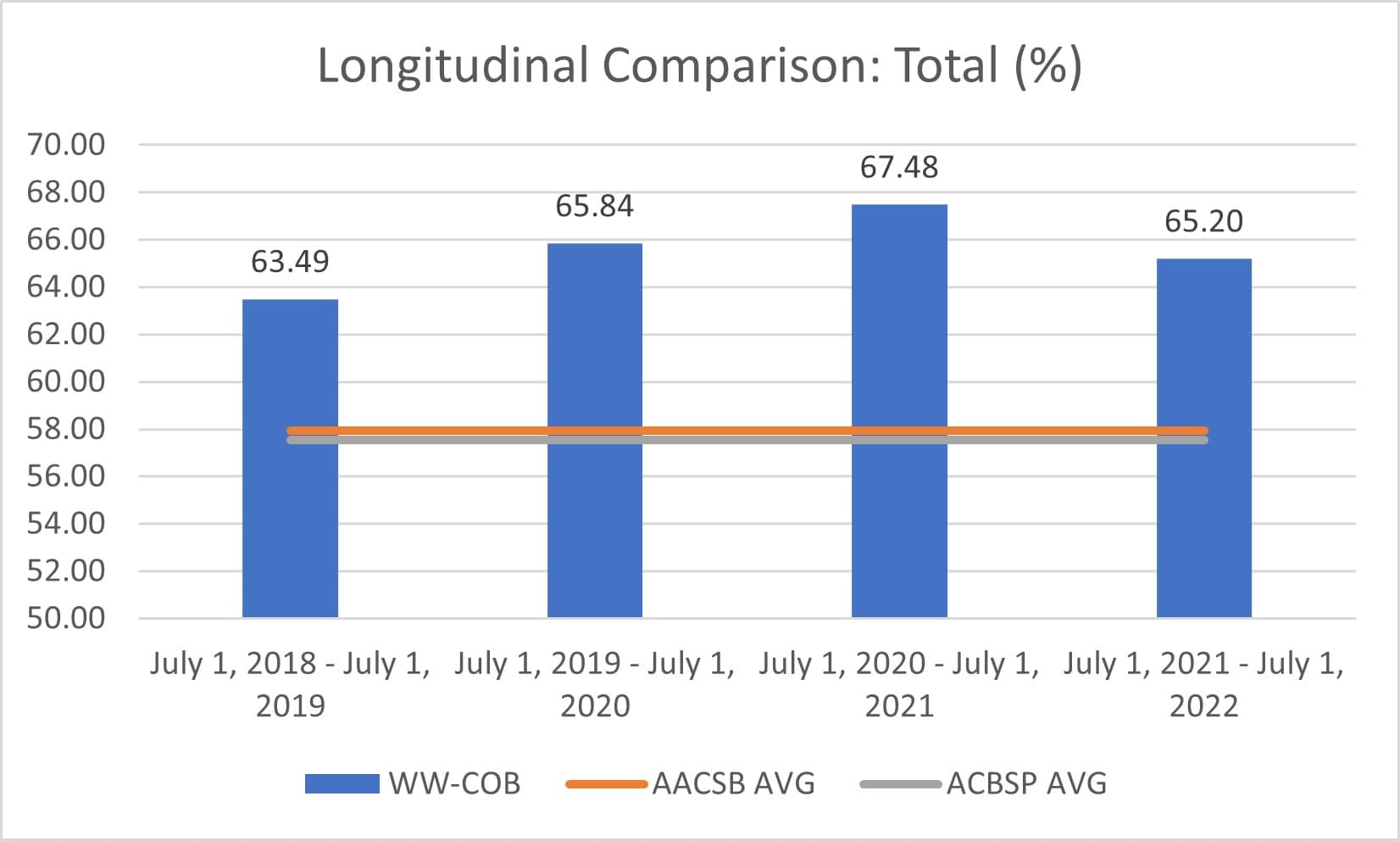
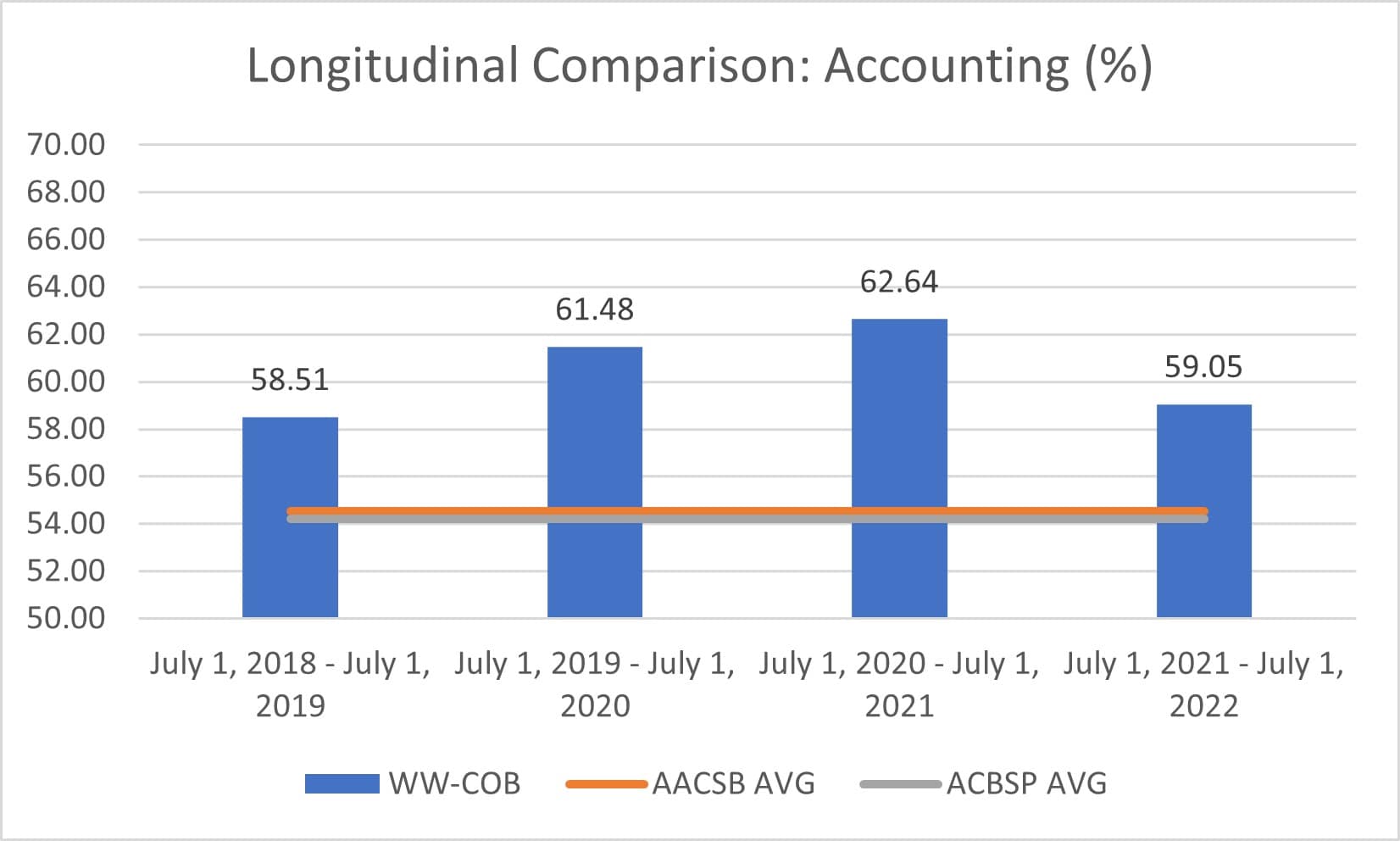
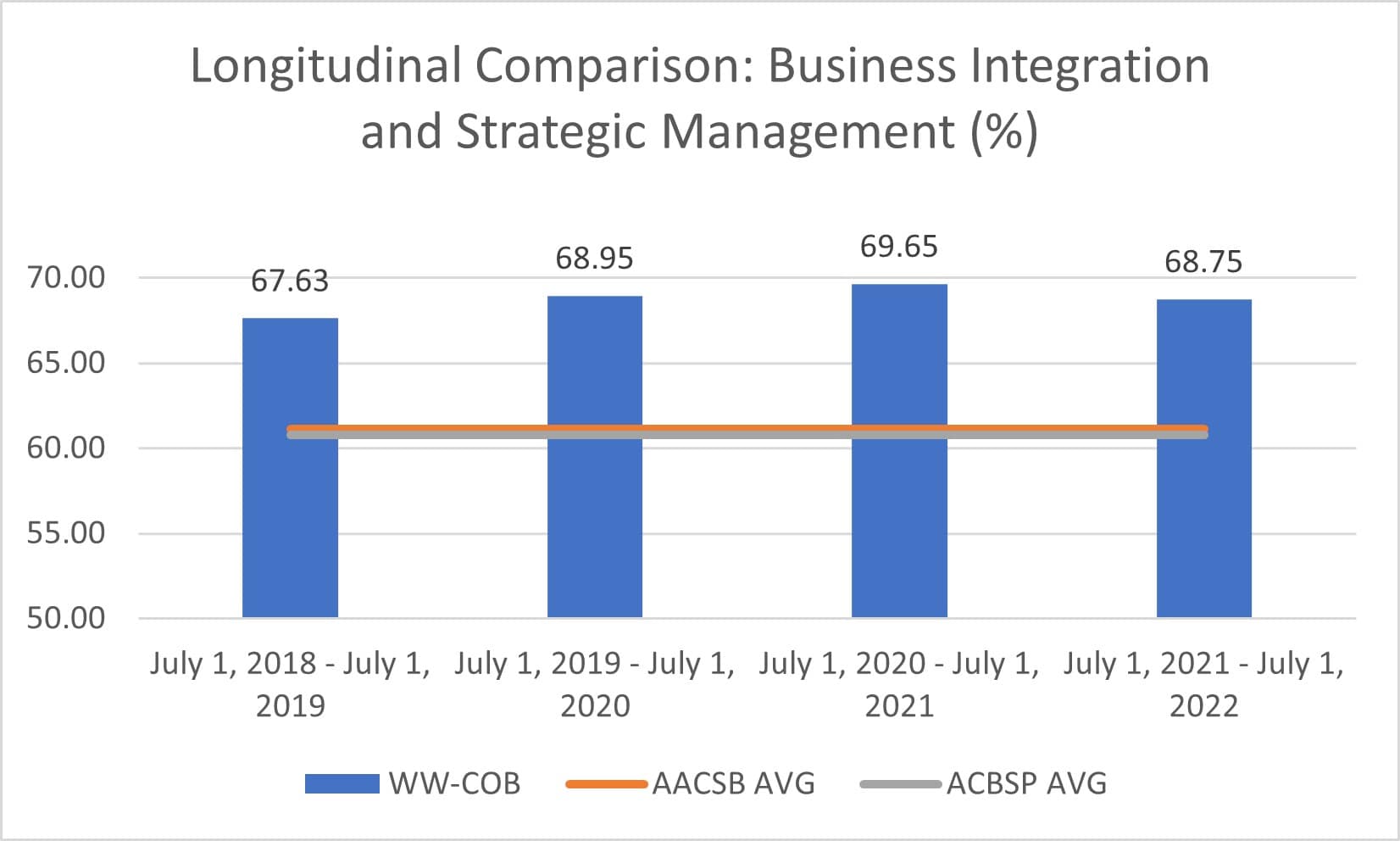
Metric 2 – Alumni Placement
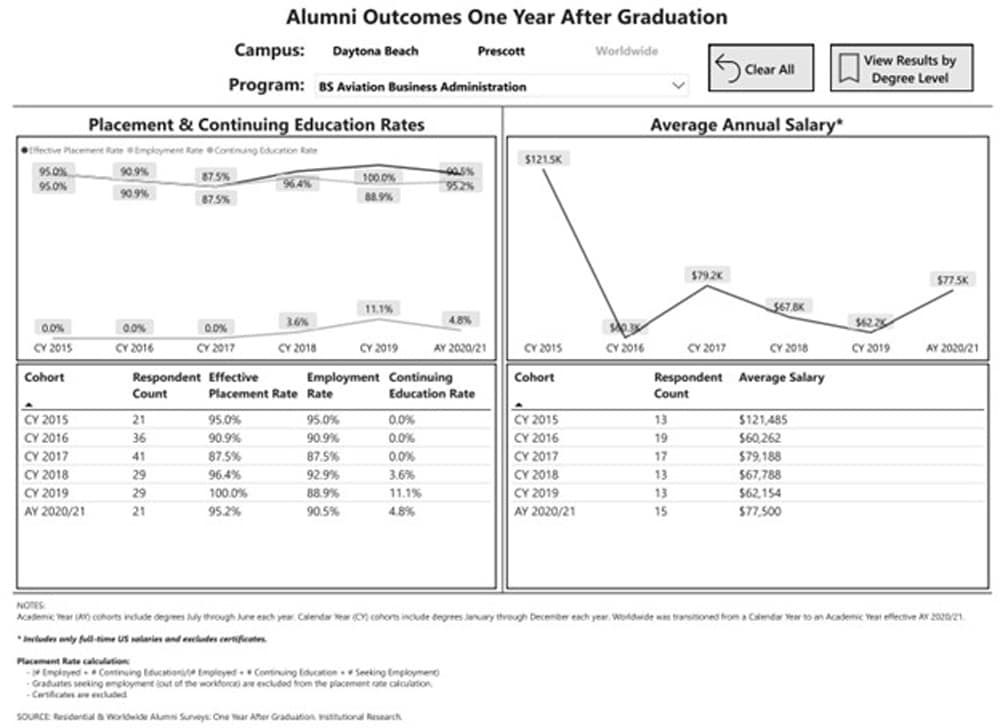
SOURCE: Worldwide Alumni Survey: One Year After Graduation. Institutional Research.
Metric 3 – Program Outcome Skills Preparedness
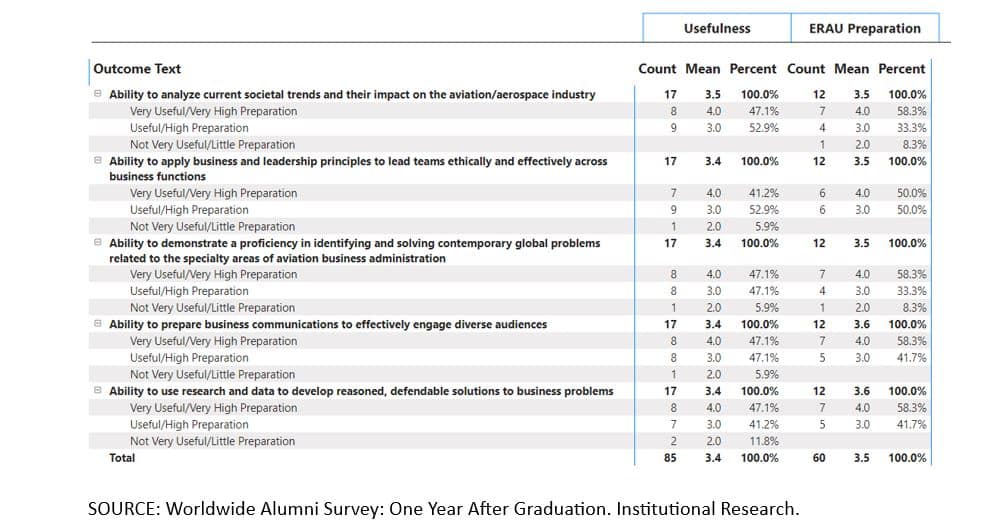
Program Mission Statement
The Bachelor of Science in Aviation Maintenance (BSAvM) is a maintenance oriented degree designed to meet the needs of the maintenance professional at all levels of the industry. Whether the student is just entering the field, already working as a mechanic/technician or has progressed into a management position, the BSAvM provides the theory and background knowledge that enables the student to grow and advance their career opportunities.
Program Outcomes
- Critical Thinking: The student will show evidence of knowledge at a synthesis level to define and solve problems within professional and personal environments.
- Quantitative Reasoning: The student will show evidence of the use of digitally-enabled technology and analysis techniques to interpret data for the purpose of drawing valid conclusions and solving associated problems.
- Information Literacy: The student will show evidence of meaningful research, including gathering information from primary and secondary sources and incorporating and documenting source material in his/her writing.
- Communication: The student will show evidence of communicating concepts in written, digital and oral forms to present technical and non-technical information.
- Scientific Literacy: The student will show evidence of analyzing scientific evidence as it relates to the physical world and its interrelationship with human values and interests.
- Cultural Literacy: The student will be able to analyze historical events, cultural artifacts, and philosophical concepts.
- Lifelong Personal Growth: The student will show evidence of the skills needed to enrich the quality of life through activities that enhance and promote lifelong learning in their career field and personal environment.
- Aviation Maintenance: The student will be able to demonstrate an understanding and application of the fundamentals of aviation maintenance, commonly accepted maintenance practices, ad global regulations applicable to the aviation maintenance industry.
- Aviation Maintenance Management: The student will demonstrate an understanding and application of management functions applicable to aviation maintenance operations for all types of aerial vehicles.
- Aviation Maintenance Safety: The student will demonstrate a comprehension and application of the basic concepts of ground and flight safety pertaining to the aviation maintenance industry.
Program Mission Statement: The Bachelor of Science degree program in Communication unites study of the written word from English programs, study of spoken and electronic messages from Communication programs, and study of an area of concentration chosen by each student. The goals of the program are (1) to educate media professionals, publicists, writers, and editors; and (2) to enhance critical thinking, understanding of the world and other knowledge bases in order for students to develop resources for life as well as for careers.
Program Educational Objectives
The engineering program will prepare...
- Technically competent graduates for a successful and productive career in the engineering profession capable of developing creative solutions to contemporary problems
- Graduates who are capable of pursuing postgraduate studies and research
- Graduates who can demonstrate their effective leadership, communication and teamwork skills in a diverse environment
- Graduates with the desire for life-long learning for the purpose of professional integrity
The Student Learning Outcomes for the BSE program are:
- an ability to identify, formulate, and solve complex engineering problems by applying principles of engineering, science, and mathematics.
- an ability to apply engineering design to produce solutions that meet specified needs with consideration of public health, safety, and welfare, as well as global, cultural, social, environmental, and economic factors.
- an ability to communicate effectively with a range of audiences.
- an ability to recognize ethical and professional responsibilities in engineering situations and make informed judgments, which must consider the impact of engineering solutions in global, economic, environmental, and societal contexts.
- an ability to function effectively on a team whose members together provide leadership, create a collaborative and inclusive environment, establish goals, plan tasks, and meet objectives.
- an ability to develop and conduct appropriate experimentation, analyze and interpret data, and use engineering judgment to draw conclusions.
- an ability to acquire and apply new knowledge as needed, using appropriate learning strategies.
Enrollment
Degrees Conferred
Program Mission Statement
The goal of the BSET degree directly supports the ERAU vision statement, “Embry-Riddle will be the world’s source for innovation and excellence in aerospace education and applied research.” Offering this degree via the Worldwide Campus will make the ERAU education in engineering more accessible and affordable while maintaining the high standards established throughout the University. Thus, it supports the ideal, “We will be a one university system with a common mission and a commitment to high quality education, but with three distinct campuses to this mission in different ways.”
The BSET supports the Worldwide Campus ideal to "serve the adult student, providing distinct and unique programs designed for students in their work environment, and promote continuing education” by offering a mix of class times and modalities for courses by attracting the more traditional younger students to an ERAU education who may not have the resources or the availability to attend the other campuses for a full four years.
Finally, it addresses the core ideal for academic programs: “We will continue to capitalize on our core competencies in aeronautical science and aerospace engineering, assuring that they are always on the cutting edge of technology and innovation. We will also strengthen our other degree offerings and explore, with faculty approval, new clusters of programs that are related to our mission, which can include but not be limited to the following: engineering, aerospace sciences, etc.”
The mission of the BSET program is to provide students with a strong background and practical knowledge in Engineering Technology. Course work is focused on the application of engineering principles.
Program Outcomes
- The student will select and apply the knowledge, techniques, skills, and modern tools of the discipline to broadly-defined engineering technology activities
- The student will select and apply a knowledge of mathematics, science, engineering, and technology to engineering technology problems that require the application of principles and applied procedures or methodologies
- The student will conduct standard tests and measurements; conduct, analyze, and interpret experiments; and apply experimental results to improve processes
- The student will design systems, components, or processes for broadly-defined engineering technology problems appropriate to program educational objectives;
- The student will demonstrate the ability to function effectively as a member or leader on a technical team; (this would be demonstrated in various ways including a group capstone project)
- The student will identify, analyze, and solve broadly-defined engineering technology problems;
- The student will apply written, oral, and graphical communication in both technical and non-technical environments; and an ability to identify and use appropriate technical literature;
- The student will demonstrate the understanding of the need for and an ability to engage in self-directed continuing professional development; (this would be done by taking continuing education courses, or engaging in technical seminars, conferences and workshops)
- The student will demonstrate the understanding of and a commitment to address professional and ethical responsibilities including a respect for diversity;
- The student will demonstrate a knowledge of the impact of engineering technology solutions in a societal and global context
- The student will exhibit a commitment to quality, timeliness, and continuous improvement in their profession.
Enrollment and Degrees Conferred
|
|
Full Time or Part Time* |
Enrollment |
Degrees Conferred** |
|
Fall 2017 |
FT |
2 |
2 |
|
|
PT |
667 |
|
|
Fall 2016 |
FT |
0 |
0 |
|
|
PT |
582 |
|
|
Fall 2015 |
FT |
0 |
0 |
|
|
PT |
249 |
|
|
Fall 2014 |
FT |
0 |
0 |
|
|
PT |
0 |
|
|
Fall 2013 |
FT |
0 |
0 |
|
|
PT |
0 |
|
|
*FT (Full-time) = 30 or more hours attempted in one year. ** Degrees Conferred data are Academic Year totals (for example, Fall 2015 is July 1, 2014 through June 30, 2015) |
|||
Program Outcomes
PO 1: Conduct scholarly research to deliver professional, written papers, presentations, and briefs.
PO 2: Demonstrate knowledge of the legal and policy structure of the homeland security enterprise.
PO 3: Design, conduct, and evaluate exercises applicable to the disciplines of homeland security.
PO 4: Demonstrate knowledge of contemporary or emergent threats, challenges or issues including natural, man-made and technological hazards.
PO 5: Recognize and define terrorism, its origins, ideologies, and goals.
PO 6: Identify infrastructures critical to the U.S. and analyze how best to protect them.
PO 7: Apply risk management principles and tools to homeland security issues.
PO 8: Analyze environmental hazards and characterize their relationship to U.S. homeland/national security.
PO 9: Analyze elements of strategic planning and decision making.
PO 10: Analyze the intelligence cycle, recognize sources and methods and explain how intelligence contributes to U.S. national/ homeland security.
PO 11: Demonstrate knowledge of cybersecurity threats, challenges, and countermeasures.
PO 12: Apply knowledge and tools gained throughout the HS program to complete a capstone course.
PO 13: Recognize the concepts of ethics and professionalism in the homeland security enterprise.
Placement and Continuing Education Rates
| Cohort | Respondent | Effective Placement Rate | Employment Rate | Continuing Education Rate | Average Salary |
| CY 2019 | 3 | 100.0% | 100.0% | 0.0% | $110,000 |
NOTES:
Academic Year (AY) cohorts include degrees July through June each year. Calendar Year (CY) cohorts include degrees January through December each year.
* Includes only full-time US salaries and excludes certificates.
Placement Rate calculation:
- (# Employed + # Continuing Education)/(# Employed + # Continuing Education + # Seeking Employment)
- Graduates seeking employment (out of the workforce) are excluded from the placement rate calculation.
- Certificates are excluded.
SOURCE: Residential & Worldwide Alumni Surveys: One Year After Graduation. Institutional Research. Microsoft Power BI
Student Achievement Data
| 2023-2024 | 2022-2023 | |
| Prospect | 105 | 71 |
| Applied | 33 | 33 |
| Admitted | 32 | 29 |
| Students - New | 14 | 20 |
| Students - Readmit | 6 | 4 |
| Students - Continuing | 111 | 109 |
| Students - Total | 131 | 133 |
Annual Degrees Conferred: Degree Program within Degree Type
|
College |
Degree Type | Degree Program | 2018-2019 | 2019-2020 | 2020-2021 | 2021-2022 | 2022-2023 |
| Arts & Sciences | Bachelor | BS Communication | 1 | 2 | 3 | 6 | 3 |
| BS Emergency Services | 13 | 12 | 9 | 15 | 3 | ||
| BS Homeland Security | 4 | 3 | 10 | 11 | 15 |
Program Mission Statement
To develop leaders through a comprehensive and practical leadership education.
Program Outcomes
- Leadership Theories: Upon completion of the BS in Leadership Program, students should be able to articulate the foundational assumptions, central ideas, and dominant criticisms of leadership theories.
- Critical Thinking: Apply critical thinking to improve leadership across a broad range of contexts.
- Communication: Construct effective formal and informal written and oral communication for a variety of audiences.
- Culture: Identify how their own cultural artifacts and diversity of culture, gender, age, sex, religion, or national perspectives impacts leadership within organizations.
- Decision making: Analyze decisions by considering multiple points of view and a variety of outcomes.
- Coaching and Mentoring: Given a set of competency, performance, or organizational objectives, devise an appropriate coaching, mentoring or training plan.
- Emotional, social, and cognitive intelligence: Develop and sustain relationships with superiors, peers, followers, and other stakeholders.
- Management and leadership skills: Know key principles of business and management disciplines and their business applications, employ skills needed to effectively lead and support teams across business functions.
Program Mission Statement
The mission of the program is to prepare the students to be successful in their career as leaders/managers by educating them with the fundamental knowledge areas of logistics and supply chain management, modeling approaches to make effective decisions, application areas, and also introducing them with the cutting edge technologies. The program also prepares the students for effective communication, legal aspects of their roles, and ethical standards to maintain in the workplace.
Program Outcomes
- Problem Solving: Demonstrate the understanding of different modeling approaches to solve problems for effective decision making
- Transportation: Demonstrate the understanding of solutions for domestic and global transportation problems.
- Inventory Management: Demonstrate the understanding of appropriate inventory management methods to optimize inventory across the supply chain.
- Information Technology: Demonstrate the understanding of information technology solutions for different business needs.
- Research: Author research papers in the appropriate scientific style.
- Distribution: Demonstrate the understanding of an organization’s warehousing and distribution needs, recommend solutions for effective and efficient distribution operations.
- Procurement: Demonstrate the understanding of purchasing policies, procedures in different business settings.
- Performance Measurement: Demonstrate the understanding of appropriate metrics to track the performance of the supply chain.
- Communication: Apply effective communication information (in oral and written forms).
Program Mission Statement
The Bachelor of Science in Project Management’s mission is to develop professionals who are capable of leading, managing and applying decision-making skills using current project management practice.
Program Outcomes
- Perform generally accepted project management techniques to plan and execute projects.
- Apply analytical tools for problem solving and effective project decision-making.
- Apply ethical behavior and communications skills within the project team environment.
- Analyze project metrics for the purpose of project reporting and control.
Placement Rates
|
Placement Rate |
||||
|
2020-21 |
2019 |
2018 |
||
|
Placement Rate |
% |
83.3% |
100% |
100% |
|
SOURCE: Worldwide Alumni Survey: One Year After Graduation. Classes of 2020-21, 2019, and 2018. Institutional Research (2023). |
||||
Graduation Rates
|
6-Year Graduation Rate |
|||
|
2016-17 cohort* |
|
||
|
Initial Program Headcount |
# |
79 |
|
|
Graduated |
# |
18 |
|
|
% |
22.8% |
|
|
|
SOURCE: Institutional Research. *First cohort reaching the 6-year reporting cycle. |
|||
Program Skills
|
TABLE A |
|
|
|
||||||
|
Class of 2020-21 |
Class of 2019 |
Class of 2018 |
|
||||||
|
M |
n |
M |
n |
M |
n |
|
|||
|
Ability to analyze project metrics for the purpose of project reporting and control |
3.4 |
12 |
3.4 |
8 |
3.2 |
5 |
|
||
|
Ability to apply analytical tools for problem solving and effective project decision making |
3.4 |
12 |
3.6 |
8 |
3.4 |
5 |
|
||
|
Ability to apply ethical behavior and communications skills within the project team environment |
3.3 |
12 |
3.8 |
8 |
3.4 |
5 |
|
||
|
Ability to perform generally accepted project management techniques to plan and execute projects |
3.3 |
12 |
3.5 |
8 |
3.2 |
5 |
|
||
|
SOURCE: Worldwide Alumni Survey: One Year After Graduation. Classes of 2020-21, 2019, and 2018. (4-Very Useful, 3-Useful, 2-Not Very Useful, 1-Not at all Useful). Institutional Research (2023). |
|||||||||
|
TABLE B |
|
|
|
||||||
|
Class of 2020-21 |
Class of 2019 |
Class of 2018 |
|
||||||
|
M |
n |
M |
n |
M |
n |
|
|||
|
Ability to analyze project metrics for the purpose of project reporting and control |
3.4 |
7 |
2.6 |
7 |
3.0 |
5 |
|
||
|
Ability to apply analytical tools for problem solving and effective project decision making |
3.3 |
7 |
2.7 |
7 |
3.0 |
5 |
|
||
|
Ability to apply ethical behavior and communications skills within the project team environment |
3.3 |
7 |
2.9 |
7 |
3.2 |
5 |
|
||
|
Ability to perform generally accepted project management techniques to plan and execute projects |
3.4 |
7 |
2.9 |
7 |
3.2 |
5 |
|
||
|
SOURCE: Worldwide Alumni Survey: One Year After Graduation. Classes of 2020-21, 2019, and 2018. (4-Very High Preparation, 3-High Preparation, 2-Moderate Preparation, 1-Little Preparation). Institutional Research (2023). |
|||||||||
Program Mission Statement
The Mission of the Bachelor of Science in Safety Management (BSSM) is to prepare students for employment in various safety-related areas and for the pursuit of advanced in safety-related degrees by educating them in the fundamentals concepts, knowledge, and laboratory/field techniques and skills of the safety sciences.
Program Outcomes
- The student will apply knowledge at the synthesis level to define and solve problems within professional and personal environments.
- The student will demonstrate the use of digitally-enabled technology (including concepts, techniques and tools of computing), mathematics proficiency & analysis techniques to interpret data for the purpose of drawing valid conclusions and solving associated.
- The student will conduct meaningful research, including gathering information from primary and secondary sources and incorporating and documenting source material in his or her writing.
- The student will communicate concepts in written, digital and oral forms to present technical and non-technical information.
- The student will be able to analyze scientific evidence as it relates to the physical world and its interrelationship with human values and interests.
- The student will be able to analyze historical events, cultural artifacts, and philosophical concepts.
- The student will be able to demonstrate the skills needed to enrich the quality of life through activities which enhance and promote lifetime learning.
- Anticipate, recognize, analyze, evaluate, and develop safety strategies for hazardous conditions and work practices.
- Demonstrate the application of safety programs through the understanding of safety and risk management concepts.
- Identify and apply applicable standards, regulations, and codes.
Student Enrollment and Graduation Data
Academic Year 2018-19
Total students enrolled: 91
Total students graduated: 1
Academic Year 2017-18
Total students enrolled: 60
Total students graduated: 0
Academic Year 2016-17
Total students enrolled: 41
Total students graduated: 0
Bachelor of Science in Technical Management
Longitudinal Analysis Report
|
Embry-Riddle Aeronautical University - Worldwide Campus |
|
|
Assessment Period: |
July 1, 2018 - June 30, 2019 |
|
Number of Exams (Outbound): |
375 |
|
Assessment Period: |
July 1, 2019 - June 30, 2020 |
|
Number of Exams (Outbound): |
400 |
|
Assessment Period: |
July 1, 2020 - June 30, 2021 |
|
Number of Exams (Outbound): |
541 |
|
Assessment Period: |
July 1, 2021 - June 30, 2022 |
|
Number of Exams (Outbound): |
518 |
|
Assessment: |
Strategic Management - 436 |


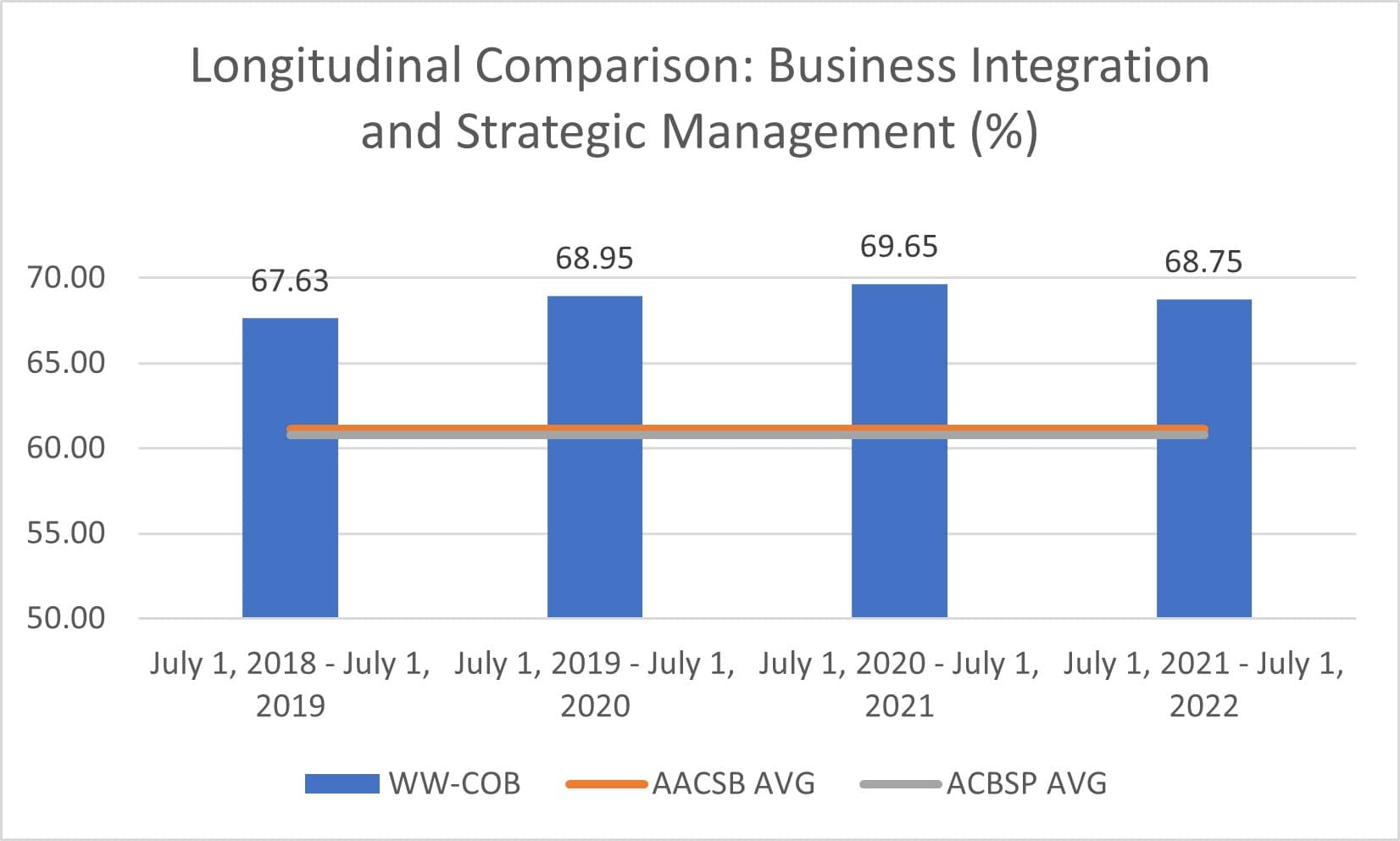
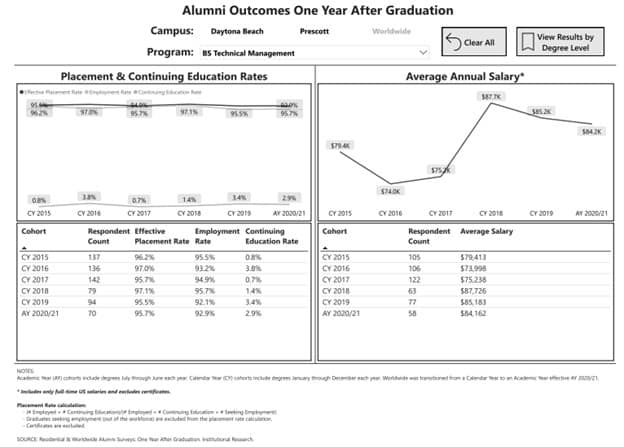

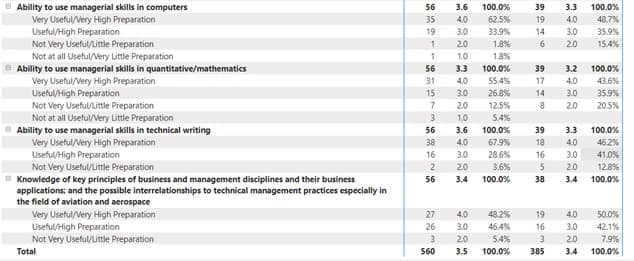
Program Mission Statement
The purpose of the Bachelor of Science in Unmanned Systems Applications (BSUSA) degree is to provide students with the knowledge, skills, attitudes, and abilities to successfully apply unmanned systems related concepts and technologies. The goal is to enable students to effectively examine specific task requirements and perceived application needs and select, recommend, design, or conceptualize applicable unmanned solutions that meet or exceed those criteria.
In this rapidly evolving, interdisciplinary new field, critical thinking, creativity, systematic problem solving, and adaptability are key traits promoted by the BSUSA and paramount to the success of its graduates. Through task oriented activities across different domains, global research, and technology enhanced education, students are given the opportunity to individually shape their learning experience around their interests and experiences while promoting an open dialogue among peers. This open ended approach enables students to apply introduced concepts across the entire spectrum of unmanned technologies and allows them to also relate to newly emerging topics and technologies in the field.
In short, the program aims to teach students to ask the right questions and guides them to finding applicable answers...
Program Goal
The goal of the BSUSA degree is to produce graduates who are qualified to enter the unmanned systems application, development, policy-making, and support workforce. The degree is focused on the application, development, and management of unmanned systems to support the evolving and rapidly changing needs of an industry experiencing significant growth, both domestically and worldwide.
Through track selection, students can chose one of three areas to focus their degree on.
In the Administration Track, the emphasis is on managerial aspects of unmanned systems applications, reaching from business considerations, over legal and regulatory requirements, to topics such as environmental compliance, safety management, or contracting and procurement.
The Operations Track focuses on individual mission support such as mission planning, payload selection, or sensor data treatment, while the
Development Track bridges the gap between engineering aspects and operational requirements. Focus in the Development track is on the task oriented implementation, combination, and/or (re)design of existing technologies to suite new applications. Software adaptation to match requirements is thereby as much an example of the Development Track goals as it is to train students to possibly become future educator and trainer in the field.
Program Outcomes
- Critical Thinking: Apply knowledge at the synthesis level to define and solve problems within professional and personal environments.
- Quantitative Reasoning: Demonstrate the use of digitally-enabled technology, including concepts, techniques and tools of computing; mathematics proficiency; and analysis techniques to interpret data for the purpose of drawing conclusions and solving associated problems.
- Information Literacy: Conduct appropriate research, including gathering information from primary and secondary sources and incorporating and documenting source material in their writing.
- Communication: Communicate concepts in written, digital and oral forms to present technical and non-technical information.
- Scientific Literacy: Analyze scientific evidence as it relates to the physical world and its interrelationship with human values and interests.
- Cultural Literacy: Analyze historical events, cultural artifacts, and philosophical concepts that are relevant to their selected field of study or influential to the development of humanity.
- Life Long Personal Growth: Develop skills needed to enrich the quality of life through activities that enhance and promote lifelong learning.
- Unmanned Systems Fundamentals: Apply the fundamentals of unmanned systems, including the technological, economical, legal, social, political, and environmental aspects of unmanned systems operations.
- Unmanned Systems Application: Evaluate and suggest appropriate unmanned systems elements, configurations, and operational criteria supporting different applications within various environments through analysis and comparison.
- Unmanned Systems Performance: Identify and apply performance criteria to solve basic operational problems such as task oriented asset and payload selection and distinction of acquisition or design criteria.
- Research: Demonstrate appropriate selection and application of research to support program objectives and solving of identified problems specific to their course subject matter.
- Unmanned Systems Administration Track: Analyze a variety of managerial aspects and examine how they apply to different unmanned systems applications. The comprehension of administrative functions within organizations and relations between entities will enable students to apply management concepts to selected unmanned systems topics.
- Unmanned Systems Operations Track: Analyze different task requirements under varying operational circumstances in order to select appropriate solutions during mission planning and execution. The comprehension of systems capabilities and limitations will enable students to support successful employment of the craft, its sensors, and/or its payload.
- Unmanned Systems Development Track: Apply engineering knowledge and skills towards the design, development, and validation of unmanned systems applications. The comprehension of operational, engineering and design, and test requirements will enable students to support development efforts in unmanned systems applications.
Worldwide Graduate Degrees
Program Mission Statement
The Master of Aviation Maintenance degree addresses ERAU core ideals for the university’s academic programs, “we will continue to capitalize on our core competencies in aeronautical science and aerospace engineering, assuring they are always on the cutting edge of technology and innovation. We will also strengthen our other degree offerings and explore, with faculty approval, new clusters of programs that are related to our mission, which can include but not be limited to the following: engineering, aerospace sciences, transportation, airport operations and management, medicine, simulation and training, etc.” This program will use courses from existing College of Aeronautics programs and create new courses ensuring students have complete understanding of the program outcomes. The core topics will feature examination and application of cutting edge technology and concepts, while encouraging diverse thinking and innovation.
Program Outcomes
- Integrate aviation maintenance within a global business environment.
- Develop strategies for managing the resources of global aviation maintenance.
- Analyze data to make decisions for gaining efficiencies within the global aviation maintenance organization.
- Integrate a safety culture into a global aviation maintenance environment.
Master of Business Administration in Aviation
Longitudinal Analysis Report
|
Assessment Period: |
July 1, 2018 - June 30, 2019 |
|
Number of Exams (Outbound): |
232 |
|
Assessment Period: |
July 1, 2019 - June 30, 2020 |
|
Number of Exams (Outbound): |
229 |
|
Assessment Period: |
July 1, 2020 - June 30, 2021 |
|
Number of Exams (Outbound): |
220 |
|
Assessment Period: |
July 1, 2021 - June 30, 2022 |
|
Number of Exams (Outbound): |
174 |
|
Assessment: |
BUSW 635 Business Strategy for Managers |

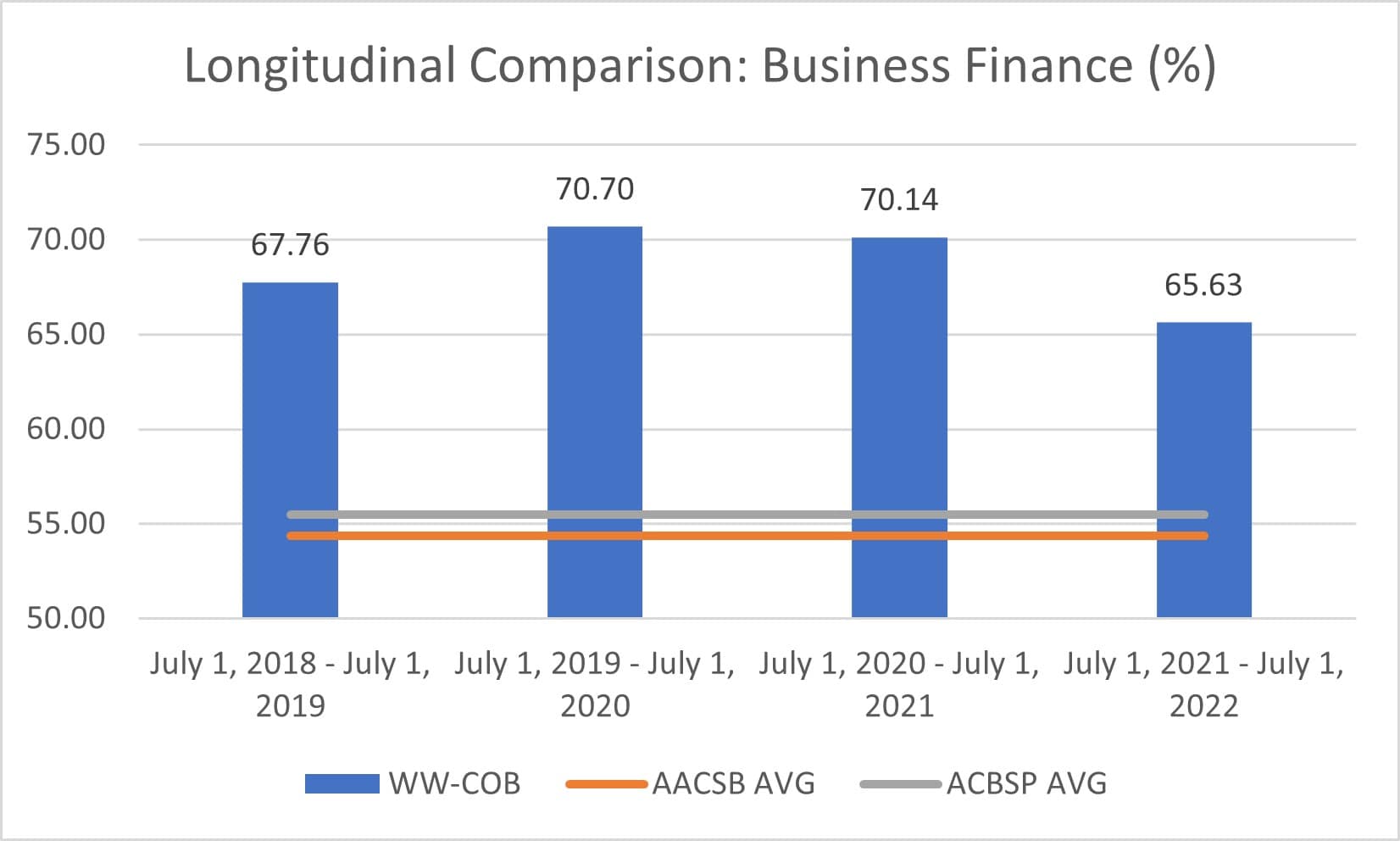
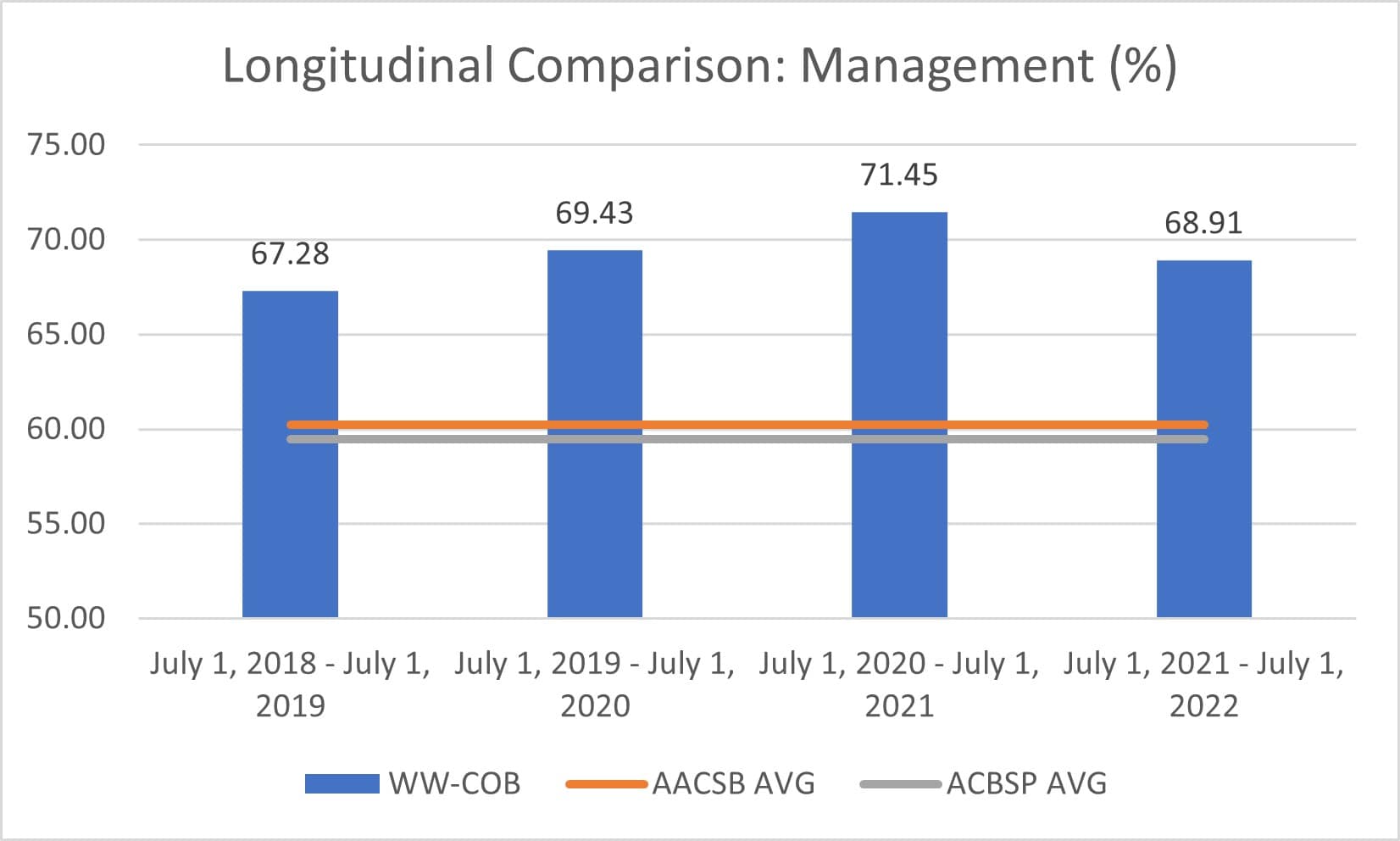
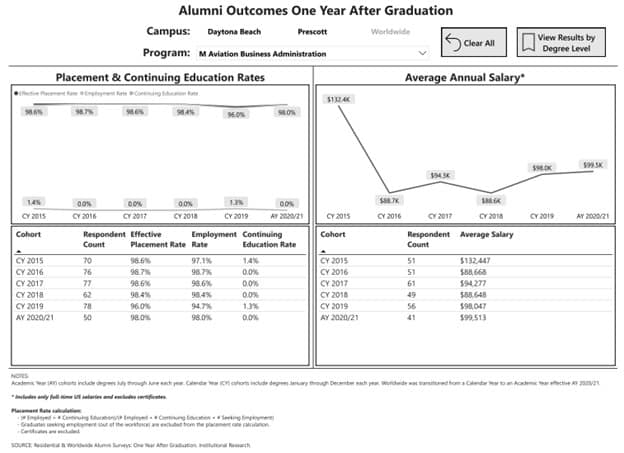

Program Mission Statement
The purpose of the Master of Entrepreneurship in Technology (MoET) degree program is to bring an educational experience tailored to meet the needs of the graduate student. Entrepreneurship is a science that transforms innovative ideas to positive economical solutions, not only for individuals but for societies. It is designed to provide the knowledge necessary to take new technological innovations to market within the aviation/aerospace industry. To provide relevant curricula in technology-based ventures with global exposure to entrepreneurial leadership within the aviation/aerospace environment. The philosophy of the program is to instill core values, professionalism, entrepreneurial vision, inspiration, knowledge, and leadership into our graduate students.
Program Goals
The MoET goals are to accomplish its mission by:
- developing critical thinking and communication skills
- developing analytical and technical skills in problem solving and research
- developing professional leadership skills
- producing graduates who are qualified to enter the entrepreneurship application; to support the workforce ranging from entry level to experienced career professionals
- collaborating with industry leaders and aviation experts worldwide
Program Objectives
The educational objectives align with the mission statement by:
- maintaining academic and professional rigor, and high quality
- providing students the necessary curricula to attain entrepreneurial success
- facilitating research and knowledge discovery
- providing students the skill-sets necessary to identify and exploit growth business opportunities in technology-based ventures
- emphasizing learning through collaboration and teamwork
- preparing students to participate in the global community
- preparing students for productive careers
Program Outcomes
- Analyze the fundamentals of entrepreneurship in today’s aviation/aerospace global marketplace.
- Identify concepts in technology and their application to entrepreneurial opportunities in the aviation/aerospace environment.
- Synthesize aviation/aerospace technology related business models for commercialization of ventures.
- Formulate strategies for managing resources of global aviation/aerospace technology ventures.
Objectives of Accredited Program
Program Mission
The purpose of the Master of Science in Aeronautics degree is to provide the highest quality graduate level education that meets — or exceeds — the needs of the aviation industry and our graduate students.
The philosophy of the Master of Science in Aeronautics is to continually advance the curriculum to meet the needs of the rapidly changing aviation environment. This occurs through the program’s utilization of professors who are experts in their specific disciplines, working to advance the field of aviation through research and scholarship.
Our goal is to maintain a leadership role in aviation-focused graduate studies through excellence, not adequacy, and we will achieve this goal by constantly improving our curriculum to meet the needs of the rapidly changing aviation environment and by utilizing only faculty who are masters in their specific disciplines. The degree provides unequaled opportunity for students to enhance their knowledge and pursue additional opportunities in the areas of unmanned aircraft systems, space studies, air traffic control, aviation education, flight crew members, flight operations specialists, and industry managers and aviation technical representatives.
Our vision is to ensure our graduates are prepared for success in their careers and that they will look back on their time with us as a positive life-changing experience. This program enables aviation/aerospace students to master the application of concepts, technology, methods and tools used in the development, manufacture, and operation of aircraft and spacecraft, as well as the public and business infrastructure that support them. To be the best of the best, we will work constantly to improve our reputation with potential employers and to earn the respect of our students, the academic community and the aviation industry.
The intent of the Master of Science in Aeronautics program is to accomplish its mission by:
- serving the student body, department, college and external community in support of the university’s overall mission
- recruiting and retaining highly qualified faculty
- maintaining strong working relationships within the aviation industry to ensure the relevance of curriculum and to promote job opportunities for graduates
- utilizing assessment techniques to continuously improve the curriculum to meet the dynamic needs of the aviation industry
- using quality control systems within the degree that will ensure graduates will have the knowledge, skills and attitudes essential to success in their professional careers.
General Criteria (a-l)
a. apply mathematics, science, and applied sciences to aviation-related disciplines;
b. analyze and interpret data;
c. work effectively on multi-disciplinary and diverse teams;
d. make professional and ethical decisions;
e. communicate effectively, using both written and oral communication skills;
f. engage in and recognize the need for life-long learning;
g. assess contemporary issues;
h. use the techniques, skills, and modern technology necessary for professional practice;
i. assess the national and international aviation environment;
j. apply pertinent knowledge in identifying and solving problems;
k. apply knowledge of business sustainability to aviation issues.
l. apply advanced qualitative and quantitative problem-solving skills.
Program Criteria
Complete a research project at the master’s or doctorial level (appropriate depth and rigor) must be required that demonstrates mastery of subject matter and data analysis and presentation. Assessment of these skills must include statistical foundations and applications, problem-solving skills at the advanced level and appropriate subject matter foundations.
Program-Specific Student Learning Outcomes
- Apply mathematics, science, and applied sciences at a level appropriate to aviation-related disciplines at the master’s level, including an adequate foundation in statistics. (ABBI 4.3.a)
- Analyze and interpret data at the master’s level. (ABBI 4.3.b)
- Work effectively on multi-disciplinary and diverse teams. (ABBI 4.3.c)
- Make professional and ethical decisions. (ABBI 4.3.d)
- Communicate effectively, using both written and oral communication skills. (ABBI 4.3.e)
- Engage in and recognize the need for life-long learning. (ABBI 4.3.f)
- Assess contemporary issues. (ABBI 4.3.g)
- Use the techniques, skills, and modern technology necessary for professional practice. (ABBI 4.3.h)
- Assess the national and international aviation environment. (ABBI 4.3.i)
- Apply pertinent knowledge in identifying and solving problems. (ABBI 4.3.j)
- Apply knowledge of business sustainability to aviation issues. (ABBI 4.3.k)
- Apply advanced qualitative and quantitative problem-solving skills. (ABBI 4.3.l)
Program Assessment Measures Employed
Direct Assessment Measures
- Student work in select course activities (exams, quizzes, homework sets, presentations, essays)
- Student work in capstone courses
- Rubric-scored portfolio assessment
- External assessments (such as FAA exams, ETS Major Field Test, Peregrine Academic Services Exam)
Indirect Assessment Measures
- End of course evaluations
- Graduating student surveys
- Alumni surveys
|
Worldwide New Students (2012-13), as of August 2018: Credentials Earned and Enrollment Status |
|||||||||
|
|
Initial Headcount |
Earned a GR certificate |
Earned a Master's degree |
Still enrolled |
|||||
|
# |
% |
# |
% |
# |
% |
# |
% |
||
|
MS Aeronautics |
F/T |
182 |
100.0% |
1 |
.5% |
125 |
68.7% |
7 |
3.8% |
|
P/T |
1097 |
100.0% |
4 |
.4% |
447 |
40.7% |
81 |
7.4% |
|
|
Total |
1279 |
100.0% |
5 |
.4% |
572 |
44.7% |
88 |
6.9% |
|
|
Source: Institutional Research. Notes: |
|||||||||
Rates and Types of Employment of Graduates
Employment Rates
| Alumni Placement Rates | ||||||
| One Year After Graduation | ||||||
| Worldwide Campus - Graduate Degrees | ||||||
| Year of Graduation | 2013 | 2014 | 2015 | 2016 | 2017 | |
| Aeronautical Science / Aeronautics (M) | (286) | (236) | (182) | (161) | (157) |
|
| Effective Placement Rate | 95.5% | 96.6% | 96.2% | 97.5% | 95.5% |
|
| Employment Rate | 95.1% | 96.2% | 96.2% | 96.9% | 94.3% |
|
| Continuing Education Rate | 0.3% | 0.4% | 0.0% | 0.6% | 1.3% |
|
|
( ) Number of Respondents |
||||||
|
* Too few respondents to report |
||||||
NOTE:
1. The effective placement rate consists of the employment rate (i.e., working at this time) plus the continuing education rate (i.e., out of the work force due to continuing education)
2. Programs with too few respondents are not listed.
3. A significant change to the survey instructions was implemented beginning with the Class of 2017: Degree completion dates were piped into the survey, and respondents asked to provide their employment status exactly one-year post-graduation. This change allows for more accurate calculation of one-year placement and employment rates. Exercise caution when making cohort comparisons.
4. A significant change to the University's rate calculations was implemented with the Class of 2017. Previously removed, alumni indicating “out of the workforce due to other reasons” are now included in all calculations and are labeled as “Not Seeking.” This change aligns the University's placement and employment rates with the standards proposed by the National Association of Colleges and Employers (NACE). This new calculation will necessarily result in lower rates than the previous formula, but ERAU rates will be more comparable to those reported by institutions adhering to the NACE standards.
SOURCE: Worldwide Alumni Survey: One Year After Graduation. Institutional Research.
Current Position Information
| MS Aeronautics / M Aeronautical Science | |
| Count | |
| Aeronautical Analyst | 1 |
| Aerospace Engineer | 1 |
| Air Navigation Services Specialist | 1 |
| Air Traffic Control Specialist | 2 |
| Air Traffic Control Supervisor | 1 |
| Air Traffic Controller | 4 |
| Air Transport Officer | 1 |
| Aircraft Maintenance Technician | 1 |
| Aircraft Mechanic II | 1 |
| Aircraft Performance Engineer Specialist | 1 |
| Aircraft Simulation Engineer | 1 |
| Airfield Operations Officer | 1 |
| Airplane Safety Engineer | 1 |
| Airport Security Coordinator | 1 |
| AIRSPEED Champion | 1 |
| Airway Transportation System Specialist | 1 |
| Analyst | 1 |
| Assistant Airfield Manager | 1 |
| Assistant Chief Pilot | 1 |
| Aviation Maintenance Duty Officer | 1 |
| Aviation Maintenance Officer | 1 |
| Aviation Operations Management | 1 |
| Aviation Safety Inspector | 1 |
| Aviation Safety Manager | 1 |
| Branch Chief | 1 |
| Captain | 1 |
| Chief Executive Officer | 1 |
| Customer Service Administrator | 1 |
| Customer Support Specialist | 1 |
| Design Engineer | 1 |
| Director | 3 |
| Engine Mechanic | 1 |
| Engineer | 1 |
| Equipment Specialist | 1 |
| Experiment Lead | 1 |
| Faculty | 1 |
| Field Operations Engineer | 1 |
| Fighter Pilot | 1 |
| First Officer | 1 |
| First Oficer | 2 |
| Flight Instructor | 1 |
| Functional Configuration Analyst | 1 |
| Helicopter Pilot | 1 |
| Instructional Designer | 1 |
| Instructor | 2 |
| Instructor Pilot | 2 |
| Instrumentation Engineer | 1 |
| Intelligence Officer | 1 |
| Lead Airport Certification Inspector | 1 |
| Maintenance Programs Engineer | 1 |
| Management Analyst | 1 |
| Manager | 1 |
| Marketing Relations Officer / Pilot | 1 |
| Mechanical Engineer | 1 |
| Meteorologist | 1 |
| Military | 2 |
| Mission Command Training Coordinator | 1 |
| Nondestructive Testing Process Engineer Technician | 1 |
| Officer | 4 |
| Operations Manager | 1 |
| Operations Officer | 1 |
| Operations Supervisor | 1 |
| Paralegal Manager | 1 |
| Paraprofessional | 1 |
| Parts Manager | 1 |
| Pilot | 21 |
| Pilot / Assistant Director - Operations | 1 |
| Pilot / Captain | 1 |
| Pilot / Chief of Operations - Standards & Evaluations | 1 |
| Pilot / Officer | 1 |
| Planner | 1 |
| Procurement Representative | 1 |
| Production Superintendent | 1 |
| Program Manager | 3 |
| Project Engineer | 1 |
| Quality Assurance Specialist | 3 |
| Quality Assurance Superintendent | 1 |
| Quality Inspector | 1 |
| Quality Manager | 1 |
| Ramp Safety Marshal | 1 |
| Research Analyst | 1 |
| Safety Officer | 2 |
| Satellite Engineer | 1 |
| Senior Airworthiness Investigator | 1 |
| Senior Associate - Cargo & Mail Operations | 1 |
| Senior Engineer | 1 |
| Senior Flight Operations Trainer | 1 |
| Senior Research Associate | 1 |
| Senior Tax Analyst | 1 |
| Senior Technical Writer | 1 |
| Service Technical Analyst | 1 |
| Simulator Instructor | 1 |
| Space Operations Officer | 2 |
| Supervisor | 1 |
| Supply Chain Management Analyst | 1 |
| Supply Chain Manager | 1 |
| Systems Engineer | 2 |
| Technical Writer | 1 |
| Test Pilot | 2 |
| Tower Operator | 1 |
| Weapon System Officer | 1 |
| NOTE: 1. Includes only those indicating they were employed one year after graduation full-time. 2. Survey Item Wording: "Please specify your position and employer information." SOURCE: 2019 Worldwide Alumni Survey: One Year After Graduation. Class of 2017. Institutional Research (2019). |
Program Mission
The Master of Science in Aerospace Engineering program exists in fulfillment of the University's mission "to provide a comprehensive education to prepare graduates for productive careers and responsible citizenship with special emphasis on the needs of aviation, aerospace engineering and related fields."
The program provides formal advanced study, preparing students for careers in the aerospace industry, and in research and development. The program adds depth in three areas of concentration (AOC): aerodynamics and propulsion, structures and materials, and dynamics and control. Focus topics of study include: aerodynamics, aero-acoustics, propulsion design, turbulence and transition, pulse detonation engines, combustion, heat transfer, hypersonics, structural analysis, vibration, nondestructive testing, thermal stresses and fatigue, composites, smart materials, elasticity, UAV's and UAS's, linear and non-linear control, rigid body dynamics, adaptive controls, and space vehicles and satellites.
Applicants must have an undergraduate degree in Aerospace Engineering, Mechanical Engineering or related fields. Applicants should also possess a strong academic background as demonstrated by their undergraduate CGPA and a healthy GRE score.
The program, be it the thesis-option or non-thesis-option, requires a total of 30 credit hours. Candidates can select courses that prepare them for the aerospace engineering profession, or for doctoral programs of study. This includes 6 credit hours of core courses within the selected AOC, 3 credit hours of graduate Mathematics, and either 21 credit hours of electives for the non-thesis option, or 12 credit hours of electives plus 9 credit hours of thesis for the thesis-option. For the non-thesis option, to graduate within a specific AOC, a student must have taken a minimum of 15 credit hours within that AOC. A maximum of 6 credit hours from outside the AE department may be applied towards the degree program.
Program Student Objectives
- Students will demonstrate an ability to use analytical methods to analyze and solve engineering problems.
- Students will demonstrate an ability to conduct research and/or independent study.
- Students will demonstrate an ability to use written and oral communication effectively.
- Students will demonstrate an ability to use numerical methods to analyze and solve engineering problems.
- Students will demonstrate an ability to use experimental methods to analyze and solve engineering problems.
Enrollment
https://ir.erau.edu/Factbook/Enrollment/PDF/ww.annualenroll.asof20-21.college&program.v1.pdf
Degrees Conferred
http://ir.erau.edu/Factbook/Degrees/PDF/WW/degrees.ww.asof20-21.college&program.v2.pdf
Program Mission Statement
The main goal of the MSAAS degree is to produce graduates who possess decision making skills that encompass sustainable strategies for aviation and aerospace industries. Through reinforcement of basic decision making skills and inclusion of consideration of other potential impacts students will be more sustainable thinking leaders and managers in global aviation and aerospace industries. The degree focuses on preparing students in the aviation and aerospace global business environment to develop sustainable strategies in managing aviation and aerospace tangible and intangible resources, projects, and promotion of practical decision making in all facets of the industries. Graduates will be able to distinguish and acclimate to the ever changing dynamics and challenges in aviation and aerospace, both domestically and internationally.
Program Outcomes
- Aviation and Aerospace Environmental and Business Based Solutions: Critique the commonalities of environmental and business based solutions for global aviation and aerospace organizations.
- Aviation and Aerospace Sustainable Operations: Interpret sustainable practices to improve workforce development and diversity, increase quality and efficiency while reducing costs in aviation and aerospace operations.
- Sustainable Best Management Practices: Evaluate sustainable best management practices.
- Aviation and Aerospace Sustainable Solutions: Develop leading edge aviation and aerospace sustainable solutions.
Program Mission Statement
The Eagle 2020 plan states that the University's mission is to "teach the science, practice and business of aviation and aerospace." The Master of Science in Cybersecurity Management and Policy degree program will create a cadre of professionals who can manage the information assets and cybersecurity practices of manufacturers, federal agencies and branches of the military, financial institutions, businesses, and other organizations that have a direct and indirect impact or tie to aviation. In addition, the degree program will add credibility and capacity to the new Security Studies and International Affairs Department, further augmenting the ability to engage in undergraduate — as well as graduate — research consistent with the goals of the Ignite Initiative.
Program Outcomes
- Bridge the major themes of the Internet, Security and Governance to be studied, as the Internet can both hinder and advance the level of security within a given population
- Identify how Internet-based services and applications have changed the ways in which groups of people and their governments communicate, organize, and act
- Analyze the role of Internet-based communications in key security events such as transnational terrorism, the Arab Spring, and Wikileaks, including government attempts to control the use of Internet-based technologies
- Express the impact of information security policies and procedures in organizational terms such as leadership, innovation through technology, human resources, financial impact, markets, and process improvement.
- Apply the aspects of the roles and responsibilities of cybersecurity management
- Assess and manage information security risks within an organization.
- Develop and implement organizational cybersecurity policies, procedures, and training programs.
- Design develop and implement effective cybersecurity policies and strategies from a broad variety of perspectives, utilizing strategies, processes and tools learned in the classroom.
- Document the role planning has in cybersecurity
- Analyze the policy objectives of the US regarding national, human and cyber security in relation to current laws.
- Differentiate US security issues and challenges along with the associated legal considerations.
- Articulate organizational planning strategies that include cybersecurity awareness and operation in all phases of the project life cycle.
- Show familiarity with research literature and analytical techniques, and conduct research independently on one or more aspects of cybersecurity management and policy
- Apply critical thinking and problem solving skills to access sources of information related to cybersecurity threats and defenses and to conduct applied research.
- Develop and apply professional management, leadership, and communication skills.
- Prepare a path to professional career advancement by adding information security knowledge and skills to existing professional experience and subject matter expertise.
Placement and Continuing Education Rates
Program Mission Statement
The Master of Science in Emergency Services prepares students for leadership positions in emergency services through experiential learning focused on critical thinking, decision making and ethical leadership. Graduates qualify for advanced leadership or managerial positions.
Program Outcomes
- Demonstrate problem-solving abilities, teamwork skills, communication competence and ethical leadership when managing complex emergencies through theoretical and simulated exercises.
- Critically evaluate emergency services rules and regulations to construct appropriate recommendations for developing new, improved emergency preparedness measures.
- Investigate strategies for managing a diverse workforce of emergency responders to evaluate the effectiveness of current leadership and management policies and procedures.
- Systematically examine the global challenges of disaster aid, terrorism, weapons of mass destruction (WMDs) and humanitarian crises to develop a critical awareness of how current problems contribute to innovative solutions to common emergency services responses.
- Develop advanced decision-making skills to respond to emergency situations using emerging technologies.
Program Mission Statement
The Master of Science in Project Management’s (MSPM) mission is to develop professionals who not only lead and manage projects and programs but can develop and operationalize project management systems and policies in organizations.
Program Outcomes
- Develop and execute projects through all phases of the lifecycle using appropriate ethical and methodological practices.
- Evaluate and deploy advanced project decision-making techniques to balance cost, schedule, scope, quality and risks to achieve project objectives.
- Evaluate and apply behavioral and communications skills to engage the project stakeholder community.
- Operationalize the critical business processes of project management in the development and implementation of strategy and competitive advantage.
Placement Rates
|
Placement Rate |
||||
|
2020-21 |
2019 |
2018 |
||
|
Placement Rate |
% |
96.3% |
95.6% |
92.6% |
|
SOURCE: Worldwide Alumni Survey: One Year After Graduation. Classes of 2020-21, 2019, and 2018. Institutional Research (2023). |
||||
Graduation Rates
|
3-Year Graduation Rate |
||||
|
2019-20 cohort |
2018-19 cohort |
2017-18 cohort |
||
|
Initial Program Headcount |
# |
115 |
145
|
191
|
|
Graduated |
# |
67 |
60 |
48 |
|
% |
41.7% |
41.4% |
35.1% |
|
|
SOURCE: Institutional Research. |
||||
Program Skills
|
TABLE A |
||||||
|
|
|
|
|
|||
|
|
Class of 2020-21 |
Class of 2019 |
Class of 2018 |
|||
|
M |
n |
M |
n |
M |
n |
|
|
Ability to develop and execute projects through all phases of the life-cycle using appropriate ethical and methodological practices |
3.3 |
22 |
3.5 |
21 |
3.7 |
20 |
|
Ability to evaluate and apply behavioral and communications skills to engage the project stakeholder community |
3.3 |
22 |
3.6 |
21 |
3.6 |
20 |
|
Ability to evaluate and deploy advanced project decision-making techniques to balance cost, schedule, scope, quality, and risks to achieve project objectives |
3.3 |
22 |
3.4 |
21 |
3.7 |
20 |
|
Ability to operationalize the critical business processes of project management in the development and implementation of strategy and competitive advantage |
3.1 |
22 |
3.2 |
21 |
3.7 |
20 |
|
SOURCE: Worldwide Alumni Survey: One Year After Graduation. Classes of 2020-21, 2019, and 2018. (4-Very Useful, 3-Useful, 2-Not Very Useful, 1-Not at all Useful). Institutional Research (2023). |
|
|||||
|
TABLE B |
||||||
|
|
Class of 2020-21 |
Class of 2019 |
Class of 2018 |
|||
|
M |
n |
M |
n |
M |
n |
|
|
Ability to develop and execute projects through all phases of the life-cycle using appropriate ethical and methodological practices |
3.3 |
22 |
3.0 |
21 |
3.4 |
20 |
|
Ability to evaluate and apply behavioral and communications skills to engage the project stakeholder community |
3.3 |
22 |
3.2 |
21 |
3.3 |
20 |
|
Ability to evaluate and deploy advanced project decision-making techniques to balance cost, schedule, scope, quality, and risks to achieve project objectives |
3.3 |
22 |
3.1 |
21 |
3.4 |
20 |
|
Ability to operationalize the critical business processes of project management in the development and implementation of strategy and competitive advantage |
3.1 |
22 |
2.8 |
21 |
3.3 |
20 |
|
SOURCE: Worldwide Alumni Survey: One Year After Graduation. Classes of 2020-21, 2019, and 2018. (4-Very High Preparation, 3-High Preparation, 2-Moderate Preparation, 1-Little Preparation). Institutional Research (2023). |
|
|||||
Program Mission Statement
The mission of the MSEM-PM certification is to develop project managers who are skilled in leading STEM professionals to produce specialized technical deliverables.
Program Outcomes
- Perform generally accepted project management techniques to plan and execute technical projects.
- Apply analytical tools for problem solving and effective project decision making.
- Apply ethical behavior and communications skills within the project team environment.
- Analyze project metrics for the purpose reporting and control of technical projects.
Placement Rates
|
Placement Rate |
||||
|
2020-21 |
2019 |
2018 |
||
|
Placement Rate |
% |
96.3% |
100% |
100% |
|
SOURCE: Worldwide Alumni Survey: One Year After Graduation. Classes of 2020-21, 2019, and 2018. Institutional Research (2023). *Includes all certificate tracks. |
||||
Graduation Rates
|
3-Year Graduation Rate |
||||
|
2019-20 cohort |
2018-19 cohort |
2017-18 cohort |
||
|
Initial Program Headcount |
# |
110 |
102 |
101
|
|
Graduated |
# |
44 |
37 |
42 |
|
% |
40.0% |
36.3% |
40.8% |
|
|
SOURCE: Institutional Research.(2023) *Includes all certificate tracks. |
||||
Program Skills
|
|
Class of 2020-21** |
Class of 2019* |
Class of 2018* |
|||
|
M |
n |
M |
n |
M |
n |
|
|
Ability to apply management techniques tailored to the STEM environment |
3.3 |
24 |
* |
* |
* |
* |
|
Ability to appraise quality management systems |
3.2 |
23 |
* |
* |
* |
* |
|
Ability to develop plans for global STEM projects and operations |
3.4 |
23 |
* |
* |
* |
* |
|
Ability to employ quantitative analysis to solve engineering management problems |
3.2 |
23 |
* |
* |
* |
* |
|
Ability to evaluate the role of ethics and professional responsibility in engineering management |
3.5 |
23 |
* |
* |
* |
* |
|
Ability to perform financial analysis for engineering projects and ongoing technical operations |
3.0 |
23 |
* |
* |
* |
* |
|
SOURCE: Worldwide Alumni Survey: One Year After Graduation. Classes of 2020-21, 2019, and 2018. (4-Very Useful, 3-Useful, 2-Not Very Useful, 1-Not at all Useful). Institutional Research (2023). * NOTE: skills measured changed as of the Class of 2020-21. ** Includes all certificate tracks. |
|
|||||
|
|
Class of 2020-21** |
Class of 2019* |
Class of 2018* |
|||
|
M |
n |
M |
n |
M |
n |
|
|
Ability to apply management techniques tailored to the STEM environment |
3.1 |
15 |
* |
* |
* |
* |
|
Ability to appraise quality management systems |
2.7 |
15 |
* |
* |
* |
* |
|
Ability to develop plans for global STEM projects and operations |
3.0 |
15 |
* |
* |
* |
* |
|
Ability to employ quantitative analysis to solve engineering management problems |
2.9 |
15 |
* |
* |
* |
* |
|
Ability to evaluate the role of ethics and professional responsibility in engineering management |
3.1 |
15 |
* |
* |
* |
* |
|
Ability to perform financial analysis for engineering projects and ongoing technical operations |
2.9 |
15 |
* |
* |
* |
* |
|
SOURCE: Worldwide Alumni Survey: One Year After Graduation. Classes of 2020-21, 2019, and 2018. (4-Very High Preparation, 3-High Preparation, 2-Litte Preparation, 1-Very Little Preparation). Institutional Research (2023). NOTE: skills measured changed in Classes of 2020-21. * NOTE: skills measured changed as of the Class of 2020-21. ** Includes all certificate tracks. |
||||||
Program Mission Statement
The Master of Science in Human Factors (MSHF) at Embry-Riddle Worldwide is multi-disciplinary degree program that will capture the expertise of aviation and aerospace professionals, and provide student with pathway through an advanced curriculum with an emphasis on scholarly research. Graduates of this program will be well suited to lead project and research teams in industry or academia. Furthermore, they will be the next generation of Human Factors professionals that establish and sustain human-centered, technology-driven research and development as they move forward into the 21st century.
The MSHF degree program is designed to provide students with knowledge and skills to allow them to operate as a competent leaders, managers, and practitioners within the field of Human Factors. Students will develop not only technical know-how but also a practical and analytical approach to problem-solving that will allow them to address a range of safety, leadership, and management challenges commonly encountered in the business environment when competing factors conflict with Human Factors findings and solutions. The objective of the MSHF degree program is to teach and train students to become effective Human Factors professionals, managers, leaders, and team members in order to provide effective and high standard work to improve effectiveness, efficiency, and safety in workplaces.
Within this context, the mission of the MSHF degree program is to provide the opportunity for students to progressively acquire a thorough grounding in the concepts and skills of the central topics in Human Factors. The program prepares students with the skills and knowledge to deliver solutions to real Human Factors problems found in operational, developmental, or simulated settings. The program will allow students to develop into effective professionals, leaders, team members, and managers, and to undertake lifelong learning, particularly for continuing professional development.
Program Outcomes
- Professional Writing, Communications, and Oral Presentation Skills: Demonstrate professional writing, communication and oral presentation skills using appropriate media and industry technology.
- HF/E Principles and Concepts to the Benefit of the Human Factors Community and Industry: Apply the fundamentals of Human Factors and Ergonomic (HF/E) principles and concepts to the benefit of the Human Factors community and to contribute to and enhance the body of scientific knowledge.
- Human Cognitive/Psychological Capabilities and Limitations: Demonstrate the ability to comprehensively evaluate human cognitive/psychological capabilities and limitations across multiple HF/E domains.
- Human Physiological Capabilities and Limitations: Demonstrate an ability to comprehensively evaluate human physiological capabilities and limitations across multiple HF/E domains.
- Human Factors Evidence-based Methodologies: Apply human factors evidence-based methodologies to identify, interpret, and define industry-based problems and develop strategies and controls to mitigate and/or solve them.
- Ethical and Professional Decision Making: Demonstrate application of ethical and professional decision making in complex socio-technical systems.
Program Mission Statement
The Master of Science in Human Security and Resilience (MS HSR) online degree will establish Embry-Riddle Aeronautical University (ERAU) as a leader in the emerging field of Human Security and Resilience, complementing the Security Studies and International Affairs (SSIA) Department’s existing undergraduate strengths in Homeland Security and Global Conflict Studies. The interrelated concepts of human security and resilience are interdisciplinary approaches which focus on the security of populations and their ability to withstand and recover from a wide array of internal and external shocks, ranging from extreme weather and destruction of critical infrastructure to terrorism and armed conflict. MS HSR program graduates will possess a deep understanding of the core issues and challenges that underlie armed conflict, emergency management, community resilience, vulnerabilities in US critical infrastructure, social change across borders, and will be capable of leading inter-disciplinary teams for policy-making, research, field action, or advocacy.
Program Outcomes
- Identify the concept of human security, its development, theoretical underpinnings, key measurements, and contrast to state-centered security models.
- Assess the relationship between human security and governance at various levels.
- Analyze the relationship between human security and conflict and its impact on the stability of the international system.
- Identify how Internet-based services and applications have changed the ways in which groups of people and their governments communicate, organize and act.
- Analyze the role of Internet-based communications in key security events, such as transnational terrorism, the Arab Spring and Wikileaks, including government attempts to control the use of Internet-based technologies.
- Demonstrate the ability to synthesize, analyze and evaluate the causes of organized communal conflict.
- Understand, evaluate, and analyze the availability and effectiveness of mechanisms for resolving communal conflicts, including diplomatic, economic, legal,military and nation-building measure.
- Demonstrate the capability to synthesize the use of diplomatic, economic, legal, military and nation-building techniques to achieve US and International security goals.
- Develop a working definition of environmental security.
- Identify the ways that the natural environment and trends such as global climate change and population growth contribute to political and economic destabilization within a country or region, and how such destabilization can lead to security concerns for the United States.
- Evaluate several definitions and source of resilience in both more and less developed countries.
- Describe why resilience should be integral to U.S. national security strategy.
- Analyze case studies in resilience that demonstrate how nations cope with conflict, resource scarcity or transnational terrorism.
- Analyze the policy objectives of the US regarding national, human, and cyber security in relation to current laws.
- Evaluate unfamiliar real-world problems involving security and cyberspace in light of existing national and international laws and policies.
- Differentiate US security issues and challenges along with the associated legal considerations.
- Show familiarity with research literature and analytical techniques, and conduct research independently on one or more aspects of human security and resilience
Placement and Continuing Education Rates
Program Mission Statement
The Master of Science in Information Security and Assurance (MSISA) degree is designed for working professionals who need to combine strong business and organizational management skills with the information systems knowledge to help their organization protect its ability to generate competitive advantage and achieve its objectives. It is designed for students who possess prior degrees in information systems, information technology, computer science, or other scientific, technical, engineering and math related management field, and who wish to further develop their knowledge, skills and abilities to plan and conduct information risk management and business continuity planning projects. The degree is designed to assist students to move into progressively more challenging managerial roles by providing a strong foundation in information and knowledge management, quality management, and information systems and technologies.
Organizations have a need for managers who understand the technical work the organization performs and can simultaneously successfully perform in management roles within the organization. The program provides a well-rounded management education, extends the students technical skills, and applies those skills to managerial functions. Additionally, the curriculum will provide students the opportunity to pursue a concentration in the following areas: Protecting Business Intelligence, Incident Investigation and Response, Information Assurance and Information Technology Security, Governance for Information and Knowledge Assurance, and Information Assurance in a Global Context. The goal of the concentrations is to allow students to tailor their program in a manner that aligns with their career objectives.
Program Outcomes
- Analyze the interdisciplinary aspects (technical, business, management, and policy) of information assurance and information systems and organizational security.
- Assess and manage the identification of and response to the changing nature of the information risks and information security challenges that increasingly complex, distributed organizations face
- Establish governance policies and management mechanisms necessary to develop, acquire, and operate sustainable, cost-effective secure information infrastructures
- Integrate various ethical, legal, technological and professional perspectives, both local and global, along with data protection and information assurance perspectives, throughout the various MIS decision making and managerial and leadership processes
- Manage and direct the development and operational use of information security and assurance procedures, policies and technologies throughout the organization
Program Mission Statement
The mission of the MSLD degree program is to provide students with a comprehensive leadership education that will position them as organizational architects of the future. We intend to create critical and strategic thinkers with a lifelong love for leadership and learning.
Program Outcomes
- Foundational Core leadership knowledge, competencies, skills, and behaviors.
- Personal Transformation and Mastery Self-awareness as a leader and a scalable framework to evaluate, assess, and renew leadership competencies.
- Group Transformation: The capacities to coach, mentor, and engage the leadership capacities of others to create high-performance teams.
- Organizational Transformation and Development Tools, techniques, and theories to diagnose organizational issues, plan effective organizational interventions and evaluate the effectiveness of organizational transformation efforts.
- Organizational Context Portable ability to apply leadership concepts and practices at different organizational levels and within diverse functional or organizational environments.
- Business Administration and Leadership Sense Making Critical understanding of how to evaluate personal experiences, prior knowledge and coursework, and organizational events within a business and leadership context
Master of Science in Logistics and Supply Chain Management
Degree Lifecycle Data
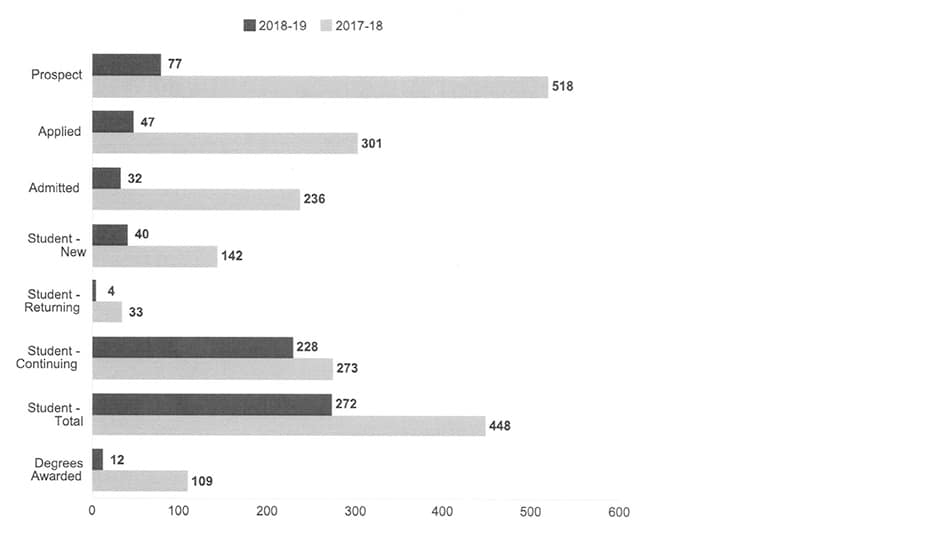
Degree Program Skills Report Results

Alumni Placement Rates
| Year of Graduation | 2013 | 2014 | 2015 | 2016 | |
|---|---|---|---|---|---|
| Aviation Business Administration (M) | (62) | (72) | (69) | (75) | |
| Effective Placement Rate | 98.4% | 93.1% | 98.5% | 98.7% | |
| Employment Rate | 98.4% | 91.7% | 97.1% | 98.7% | |
| Continuing Education Rate | 0.0% | 1.4% | 1.4% | 0.0% | |
| Logistic & Supply Chain Management (M) | (13) | (21) | (19) | (38) | |
| Effective Placement Rate | 100.0 | 90.5% | 94.7% | 94.7% | |
| Employment Rate | 100.0 | 90.5% | 94.7% | 94.7% | |
| Continuing Education Rate | 0.0% | 0.0% | 0.0% | 0.0% | |
| Management (M) | (44) | (31) | (30) | (40) | |
| Effective Placement Rate | 97.7% | 100.0% | 100.0% | 97.5% | |
| Employment Rate | 97.7% | 100.0% | 100.0% | 97.5% | |
| Continuing Education Rate | 0.0% | 0.0% | 0.0% | 0.0% |
Master of Science in Management
Longitudinal Analysis Report
|
Embry-Riddle Aeronautical University - Worldwide Campus |
|
|
Assessment Period: |
July 1, 2018 - June 30, 2019 |
|
Number of Exams (Outbound): |
232 |
|
Assessment Period: |
July 1, 2019 - June 30, 2020 |
|
Number of Exams (Outbound): |
229 |
|
Assessment Period: |
July 1, 2020 - June 30, 2021 |
|
Number of Exams (Outbound): |
220 |
|
Assessment Period: |
July 1, 2021 - June 30, 2022 |
|
Number of Exams (Outbound): |
174 |
|
Assessment: |
BUSW 635 Business Strategy for Managers |

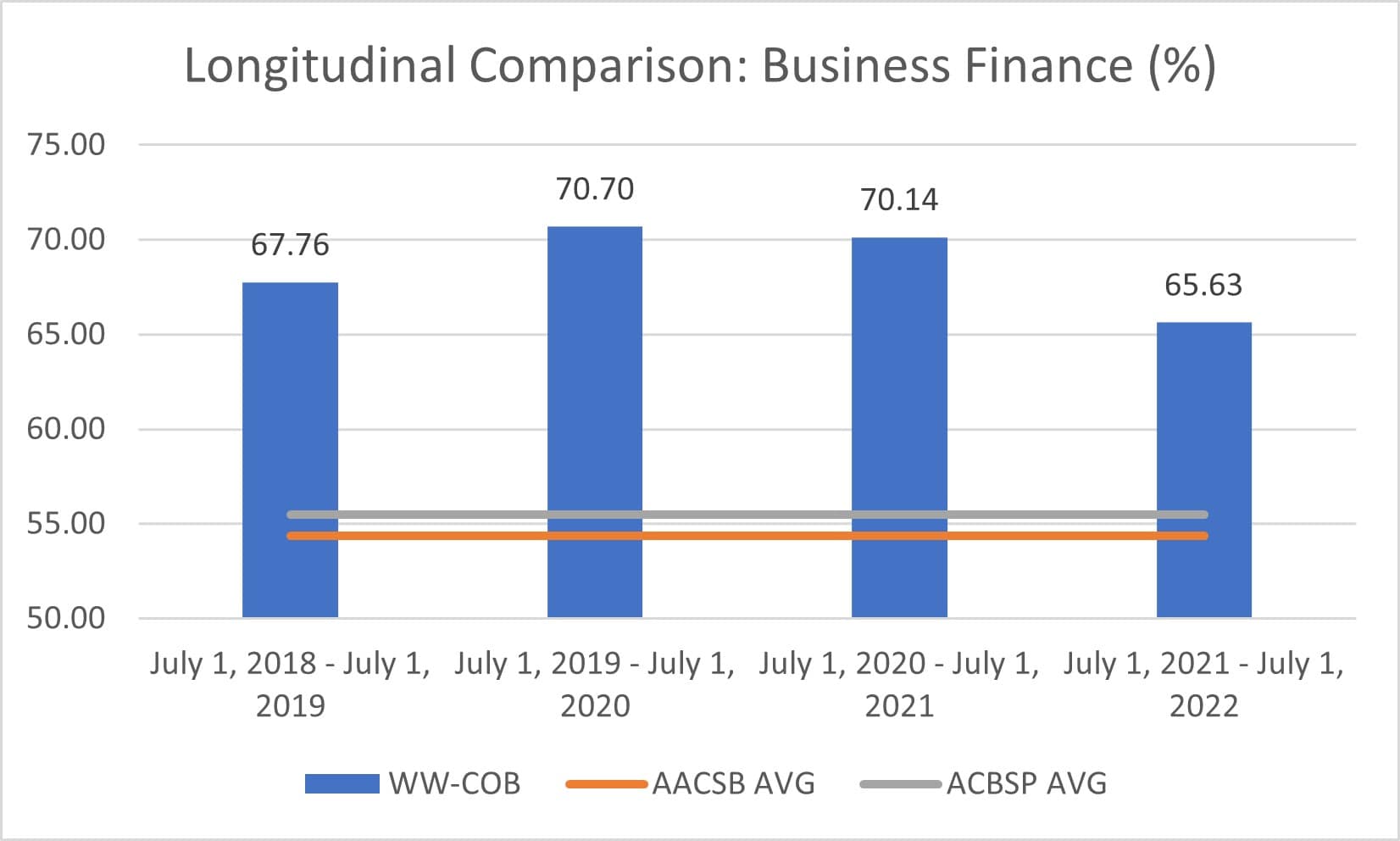
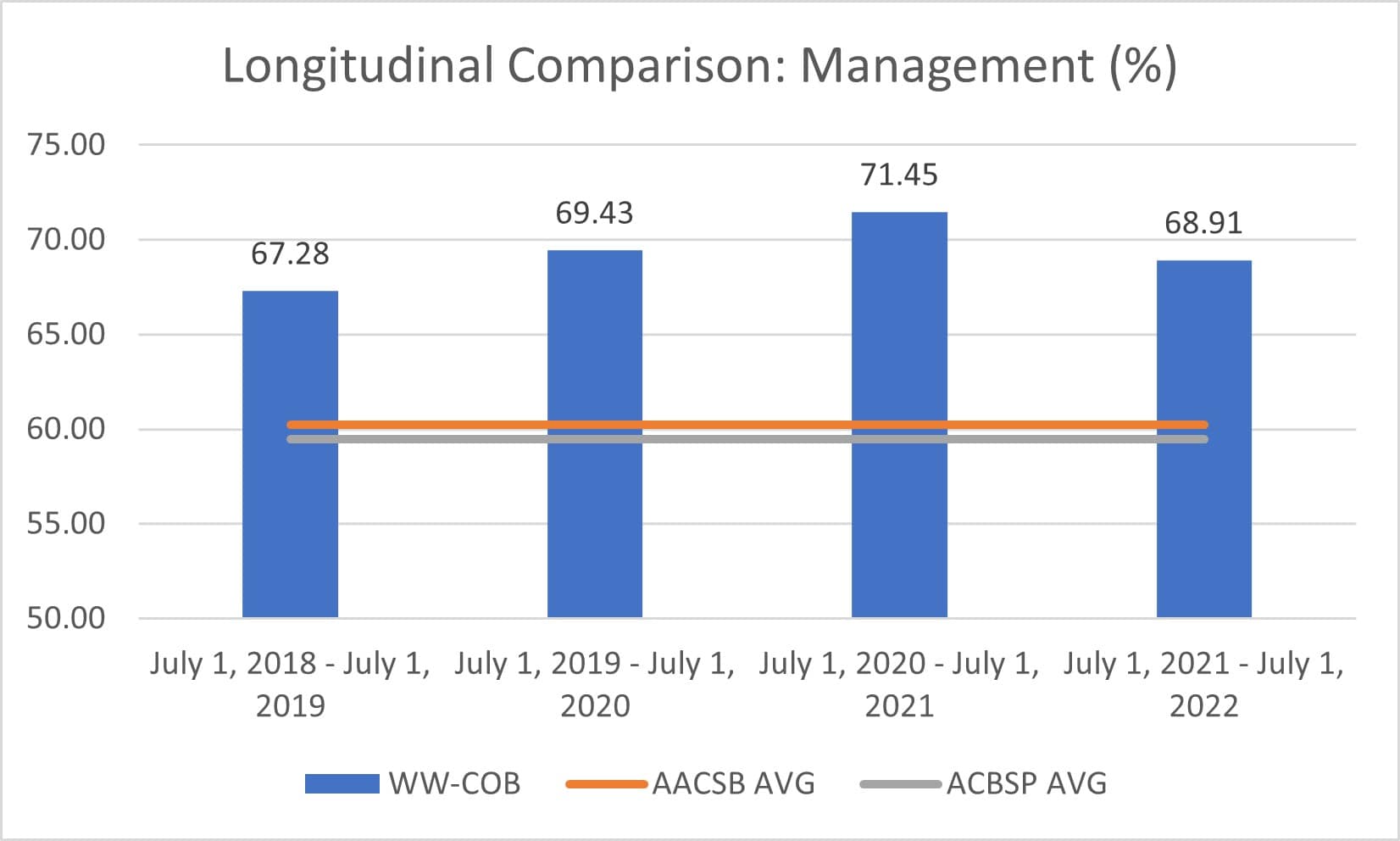
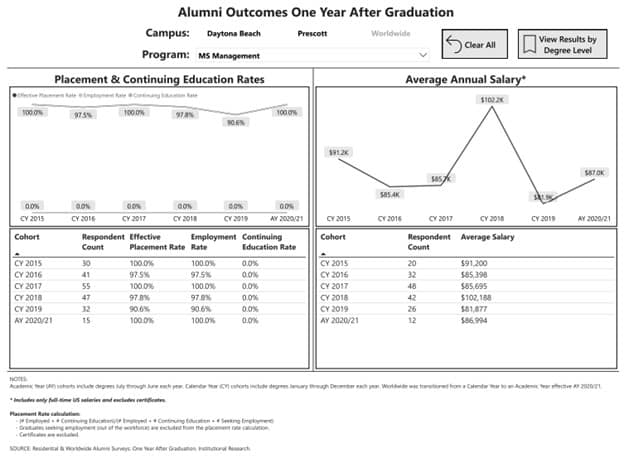
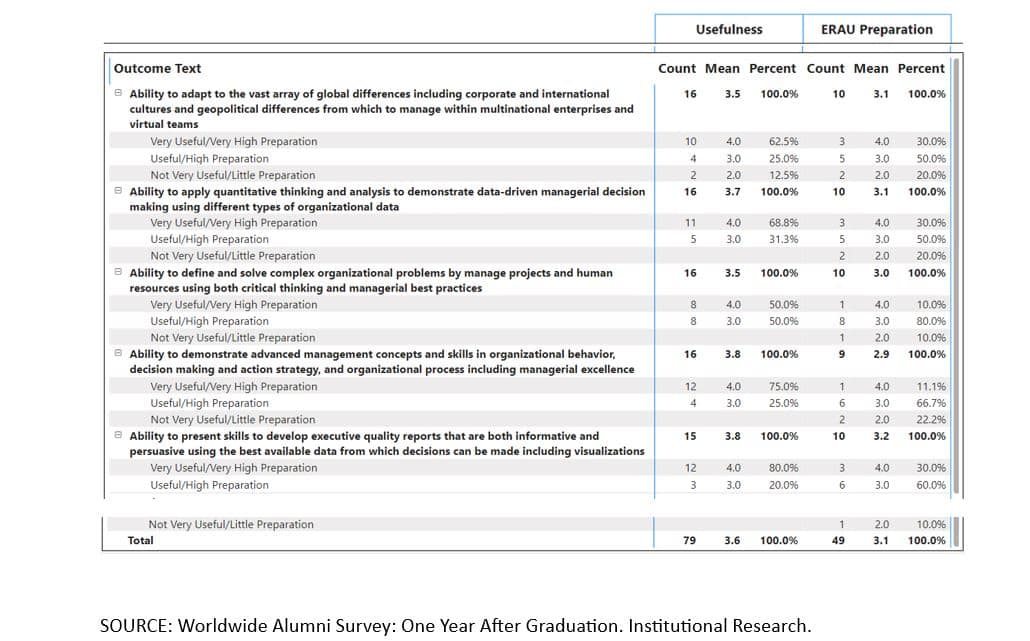
Program Mission Statement
The Master of Science in Management Information Systems degree equips its graduates to help their organizations critically examine the many ways that information and information systems help the organization identify critical opportunities and solve key issues that they face. It provides information systems and other working professionals in the sciences with the skills they need to advance their careers on a managerial career path. MSMIS courses bridge the gap between information systems and management by combining the technical background of these professionals with the key elements of a typical business education, producing business-ready information systems managers. Its students explore the relationship between the sciences and technologies that present new and exciting opportunities every day to virtually every kind of organization large or small. Students also are challenged to combine a systems engineering mind set, with the bottom-line business acumen necessary to make the correct business case to support the decisions necessary to seize the right opportunities, and make them successful.
The MSMIS program produces mature, developed, responsible, and ethical graduates ready for immediate productivity and career growth.
Program Outcomes
- IT Concepts and Skills: Evaluate the role of information and knowledge in organizations and apply system development and project management principles to support the accomplishment of organizational goals and objectives
- Quality Management and Business Improvements Skills: Integrate the principles of quality management to implement continuous business process improvements that achieve information systems’ reliability and robustness in sustainable ways.
- Systems Reengineering Skills: Apply systems engineering principles to the requirements analysis, design, development, implementation and operational support of enterprise systems
- Ethics: Integrate various ethical, legal, technological and professional perspectives, both local and global, throughout the various MIS decision making and managerial and leadership processes
- Leadership and Management Skills: Evaluate the various aspects of information and technology alternatives, stewardship and governance within different organizational and mission contexts
Program Mission Statement
The Master of Science in Occupational Safety Management (MSOSM) degree program provides the safety, health and environmental professional or aspiring professional with an advanced educational experience to enhance the practice of occupational safety, health and environmental management. This graduate degree provides the requisite skills, knowledge and credentials necessary to succeed in the practice of safety and also provides specialized skills and knowledge needed to achieve leadership positions in the safety, health, and environmental fields. The MSOSM degree prepares graduates for several professional careers, such as director of safety, safety manager, safety consultant, compliance officer, or loss control manager, in virtually every occupational setting including heavy industry, light manufacturing, construction, transportation, service industries, federal, state, and local government operations, and insurance companies.
Program Educational Objectives
Program educational objectives are broad statements that describe what graduates are expected to attain within a few years after graduation. Program educational objectives are based on the needs of the program’s constituencies.
- Apply a broad educational background combined with strong critical thinking, analytical and time management skills to lead, influence and achieve the OSH goals and objectives of their employers.
- Effectively communicate, collaborate, and manage a professionally diverse and inclusive work environment.
- Manage and lead OSH organizations in an ethical and professional manner.
- Engage in professional development and mentor others to demonstrate competency; ensure relevancy in knowledge, skills and new technologies; and maintain currency in changing industry trends.
- Anticipate, recognize, evaluate, prevent and control hazards to better ensure safe workplaces and develop best practices.
Program Student Outcomes
Student outcomes describe what students are expected to know and be able to do by the time of graduation. These relate to the knowledge, skills and behaviors that students acquire as they progress through the program
Students will:
- Have the ability to identify, formulate and solve broadly defined technical or scientific problems by applying knowledge of mathematics and science and/or technical topics to areas relevant to the discipline.
- Have the ability to formulate or design a system, process, procedure or program to meet desired needs.
- Have the ability to function effectively on teams that establish goals, plan tasks, meet deadlines, and analyze risk and uncertainty.
- Have the ability to anticipate, recognize, evaluate, prevent, and control workplace safety and occupational health hazards within numerous industries to protect people, property, the environment and organizational operations.
- Have an ability to effectively manage the occupational safety and health function within a variety of industries.
- Have an ability to justify occupational safety and health programs, initiatives and control efforts through the use of business and risk management metrics, by maintaining compliance with applicable standards and regulations, or through scientific evaluation of outcomes.
- Have an ability to effectively communicate and interact with persons at all levels within an organization and externally about occupational safety, health and environmental management.
- Have the ability to practice and perform in an ethical, moral, responsible and accountable manner in all aspects, but especially in the practice of safety, understanding the impact of technical and/or scientific solutions in global, economic, environmental and societal contexts.
- Have the ability to identify an occupational safety and health research problem; complete a thorough review of the scholarly literature; formulate and test hypotheses or research questions; collect and appropriately analyze qualitative or quantitative data; and interpret and report research findings using scientific judgment to improve the field of occupational safety and health or to provide solutions to an occupational safety and health problem.
Student Enrollment and Graduation Data
Academic Year 2022-23
Total students enrolled:169
Total students graduated: 50
Academic Year 2021-22
Total students enrolled: 204
Total students graduated: 35
Academic Year 2020-21
Total students enrolled:189
Total students graduated: 38
Academic Year 2019-20
Total students enrolled: 191
Total students graduated: 38
Academic Year 2018-19
Total students enrolled: 206
Total students graduated: 37
Academic Year 2017-18
Total students enrolled: 224
Total students graduated: 49
Academic Year 2016-17
Total students enrolled: 233
Total students graduated: 36
Program Mission Statement
The Master of Science in Project Management’s (MSPM) mission is to develop professionals who not only lead and manage projects and programs but can develop and operationalize project management systems and policies in organizations.
Program Outcomes
- Develop and execute projects through all phases of the lifecycle using appropriate ethical and methodological practices.
- Evaluate and deploy advanced project decision-making techniques to balance cost, schedule, scope, quality and risks to achieve project objectives.
- Evaluate and apply behavioral and communications skills to engage the project stakeholder community.
- Operationalize the critical business processes of project management in the development and implementation of strategy and competitive advantage.
Placement Rates
|
Placement Rate |
||||
|
2020-21 |
2019 |
2018 |
||
|
Placement Rate |
% |
96.3% |
95.6% |
92.6% |
|
SOURCE: Worldwide Alumni Survey: One Year After Graduation. Classes of 2020-21, 2019, and 2018. Institutional Research (2023). |
||||
Graduation Rates
|
3-Year Graduation Rate |
||||
|
2019-20 cohort |
2018-19 cohort |
2017-18 cohort |
||
|
Initial Program Headcount |
# |
115 |
145
|
191
|
|
Graduated |
# |
67 |
60 |
48 |
|
% |
41.7% |
41.4% |
35.1% |
|
|
SOURCE: Institutional Research. |
||||
Program Skills
|
TABLE A |
||||||
|
|
|
|
|
|||
|
|
Class of 2020-21 |
Class of 2019 |
Class of 2018 |
|||
|
M |
n |
M |
n |
M |
n |
|
|
Ability to develop and execute projects through all phases of the life-cycle using appropriate ethical and methodological practices |
3.3 |
22 |
3.5 |
21 |
3.7 |
20 |
|
Ability to evaluate and apply behavioral and communications skills to engage the project stakeholder community |
3.3 |
22 |
3.6 |
21 |
3.6 |
20 |
|
Ability to evaluate and deploy advanced project decision-making techniques to balance cost, schedule, scope, quality, and risks to achieve project objectives |
3.3 |
22 |
3.4 |
21 |
3.7 |
20 |
|
Ability to operationalize the critical business processes of project management in the development and implementation of strategy and competitive advantage |
3.1 |
22 |
3.2 |
21 |
3.7 |
20 |
|
SOURCE: Worldwide Alumni Survey: One Year After Graduation. Classes of 2020-21, 2019, and 2018. (4-Very Useful, 3-Useful, 2-Not Very Useful, 1-Not at all Useful). Institutional Research (2023). |
|
|||||
|
TABLE B |
||||||
|
|
Class of 2020-21 |
Class of 2019 |
Class of 2018 |
|||
|
M |
n |
M |
n |
M |
n |
|
|
Ability to develop and execute projects through all phases of the life-cycle using appropriate ethical and methodological practices |
3.3 |
22 |
3.0 |
21 |
3.4 |
20 |
|
Ability to evaluate and apply behavioral and communications skills to engage the project stakeholder community |
3.3 |
22 |
3.2 |
21 |
3.3 |
20 |
|
Ability to evaluate and deploy advanced project decision-making techniques to balance cost, schedule, scope, quality, and risks to achieve project objectives |
3.3 |
22 |
3.1 |
21 |
3.4 |
20 |
|
Ability to operationalize the critical business processes of project management in the development and implementation of strategy and competitive advantage |
3.1 |
22 |
2.8 |
21 |
3.3 |
20 |
|
SOURCE: Worldwide Alumni Survey: One Year After Graduation. Classes of 2020-21, 2019, and 2018. (4-Very High Preparation, 3-High Preparation, 2-Moderate Preparation, 1-Little Preparation). Institutional Research (2023). |
|
|||||
Program Mission
The Master of Science in Unmanned and Autonomous Systems Engineering (MSUASE) degree is a 30-credit, online program designed to enable career establishment and advancement in a rapidly changing field. The program features the development of innovative solutions operating along the spectrum of autonomy, including unmanned aircraft, autonomous cars, robotic surface and underwater vessels, spacecraft, and industrial robots. The degree is built on rigorous multi-disciplinary coursework to provide a flexible option to develop and demonstrate knowledge attainment through project-based experiences. The curriculum features integration and application of concepts, protocols, and techniques in unmanned and autonomous systems: systems engineering, architecture, and design; safety and certification; requirements development analysis; modeling; command, control, and communication (C3); and human factors. Through the review of design, performance, and operational specifications to system testing and evaluation of end-to-end solutions, students gain comprehensive insight and practical experience affecting development, acquisition, fielding, and sustainment of unmanned system designs. The MSUASE culminates in a two-term capstone project, conducted independently or in a team setting, to develop a technical solution to a critical real world challenge and leading to publication.
Program Student Outcomes
- Unmanned System Engineering Fundamentals: Demonstrate ability to apply engineering concepts, practices, and methods towards the design of unmanned and/or autonomous systems, including integration of subsystems, elements and components, to meet a clearly established and justifiable need
- Unmanned Systems Challenges: Compare and contrast contemporary unmanned system issues, including those relating to social, economic, ethical, health and safety, manufacturability or sustainability, to identify contributing factors and formulate strategies to address or further investigate
- Engineering Innovation and Adaptation: Evaluate and recommend appropriate incorporation of new technologies, methods, processes, or concepts toward the engineering of unmanned and autonomous systems throughout their lifecycle
- System Architectural Design: Critically justify and validate systems architectural design, including functional, physical and operational configurations, and address requirements through analysis
- Communication and Information Dissemination: Effectively communicate concepts, designs, theories, and supporting material with others in the unmanned systems field
- Unmanned System Design Certification: Exhibit an understanding of current standards, guidance materials, and best practices and their role toward the certification of unmanned and autonomous systems
- Unmanned System Engineering Research and Design: Investigate and address a current unmanned systems research problem through engineering design and development, featuring thorough review of scholarly literature; formulation of hypotheses; collection and analysis of data; and, interpretation and reporting of research findings to provide feasible solution to identified problem or add new knowledge to the field
Enrollment
https://ir.erau.edu/Factbook/Enrollment/PDF/ww.annualenroll.asof20-21.college&program.v1.pdf
Degrees Conferred
http://ir.erau.edu/Factbook/Degrees/PDF/WW/degrees.ww.asof20-21.college&program.v2.pdf
Program Mission Statement
The Master of Science in Unmanned Systems (MSUS) degree program provides students with an education focused on gaining and applying knowledge necessary for success within the unmanned systems industry. The educational focus supports the growth, innovative development, and effective use of unmanned system technology across the respective domains to address major challenges within the industry, which include interoperability, autonomy, airspace integration, communications, education and training, propulsion and power, teaming, and regulation. Professionals with the ability to identify trends, analyze requirements, develop strategies, recommend solutions, recognize opportunities for innovation, and clearly communicate from a rich knowledge and experience base will be valuable contributors, essential to the success of the developing industry in the global market. Students are provided an opportunity to select combinations of advisor approved courses individually or from specified concentrations, including unmanned aerospace systems (UAS), aeronautics and design, human factors, space systems, safety/emergency response, operations, education, aviation/aerospace management, and aviation/aerospace research. The selection of topical relevant electives provides the flexibility to tailor the program to the requirements and goals of each student, while retaining continuity with the overall goal of the degree to address the growing and dynamic needs of the industry. The MSUS provides an interactive learning environment to acquire and apply knowledge, work in independent and team settings, communicate across a geographically and experientially diverse population, and assume leadership roles, which represent the fundamental skills necessary to establish or advance a successful career in today’s competitive and collaborative working environment.
Program Outcomes
- Unmanned Systems Fundamentals: Analyze the fundamentals of unmanned systems, including the technological, social, environmental, and political aspects of the system to examine, compare, analyze and recommend conclusions
- Unmanned Systems Challenges and Responses: Compare and contrast current unmanned system issues, identify contributing factors, and formulate strategies to address or further investigate
- Unmanned Systems Innovation: Evaluate and recommend the incorporation of new technologies, methods, processes, or concepts with current unmanned system applications, management practices, or operational policies
- Unmanned Systems Design Configurations: Critically justify and validate unmanned system design configurations to support safe, efficient, and effective operations in applicable domains (air, space, ground, and maritime), including assessing appropriateness of major elemental components; evaluating limitations and constraints; formulating theory of operation; and supporting perceived need
- Unmanned Systems Communicating Information: Effectively communicate concepts, designs, theories, and supporting material with others in the unmanned systems field
- Unmanned Systems Investigation, Research, and Analysis: Investigate a current unmanned systems research problem; complete a thorough review of the scholarly literature; formulate hypotheses; collect and appropriately analyze data; and, interpret and report research findings to improve the field of unmanned systems or to provide solutions to an unmanned systems application problem
Program Mission
The ERAU Master of Systems Engineering (MSysE) is designed to equip engineers and managers with the knowledge, tools, and perspective necessary for the analysis, development, and management of systems (products and services) that address customer requirements. The MSysE seeks to do this by considering engineering, technology, environmental, management, risk and economic factors through viewing the system as a whole over its life cycle.
Program Student Objectives
- Systems Thinking - Students will understand systems concepts, including the relations among subsystems; will understand the needs of the super-system and their impact on system development; and will understand how the business (enterprise) and technology environment influences system development and its effect on its operating and social environment.
- Holistic Lifecycle View - Students will be able to analyze stakeholder needs to establish and manage system requirements throughout its life cycle. Students will also be able to evaluate the impact of system requirements in terms of the draw of developmental and operational resources, and the interaction of the system with its environment.
- System Design - Students will understand and be able to apply different types of system architectures; will be able to evaluate alternatives in developing system concepts; will understand the need for designing for a system’s life cycle; and will be able to develop the processes for validating and verifying a system’s design and transition to operation.
- Systems Engineering Management - Students will understand the coordination of system life cycle activities and the concurrent development of systems elements; will be able to incorporate the timely integration of both enterprise functions and system specialties into a system’s development; will be able to employ a life cycle process for a given system; and will be able to select appropriate systems engineering planning, monitoring and controlling, and the logistics and operations methods to effect robust system development and implementation.
Enrollment
https://ir.erau.edu/Factbook/Enrollment/PDF/ww.annualenroll.asof20-21.college&program.v1.pdf
Degrees Conferred
http://ir.erau.edu/Factbook/Degrees/PDF/WW/degrees.ww.asof20-21.college&program.v2.pdf

